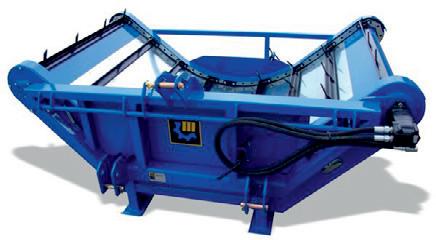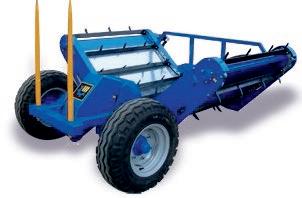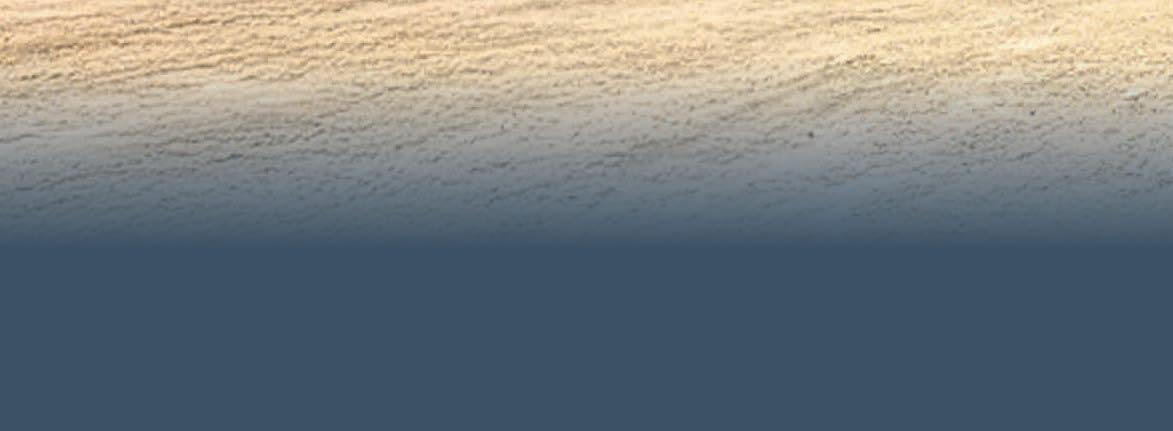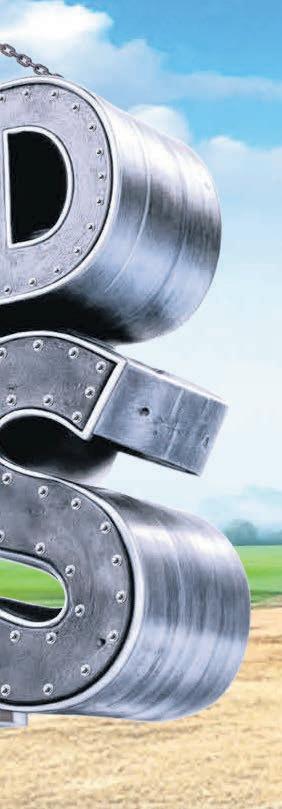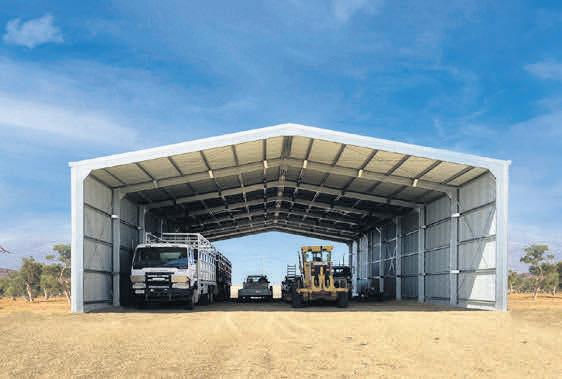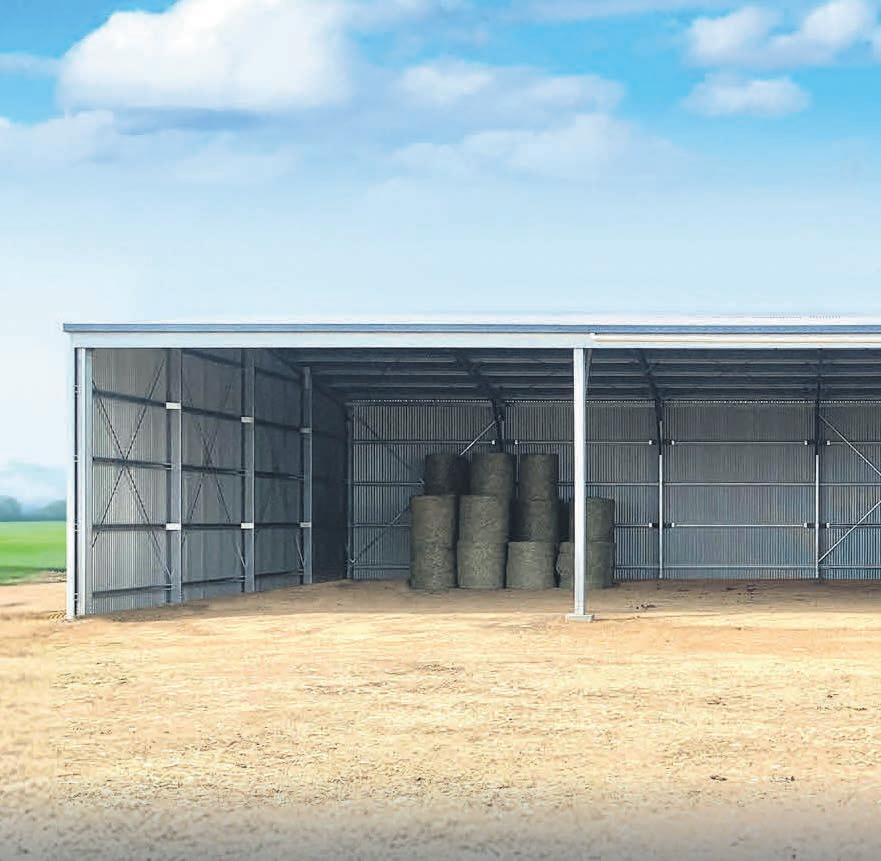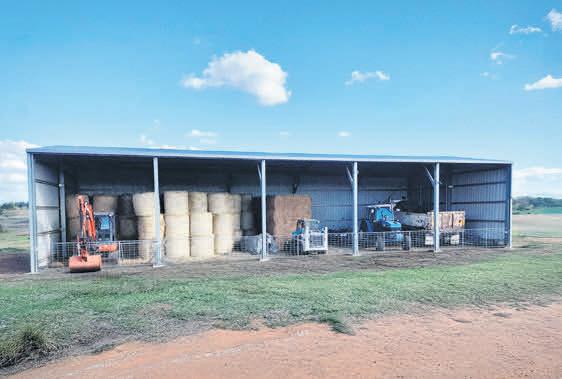




























BY MADELYN IRVINE
THE INPUTS market is in a considerably different position compared to this time last year.
From varied weather conditions across Australia to changes in global supply and demand, the market is facing pressures on multiple fronts.
Weather has played a major role in shaping the current situation.
While March 2024 recorded lower rainfall deciles than March 2025 across many dairying regions, it followed a much wetter summer.
January 2024 delivered widespread above-average rainfall to nearly all dairying areas.
In contrast, this season has been marked by prolonged dry conditions in the south, particularly in South Australia, where multiple months of below-average rainfall have placed mounting pressure on feed and water availability.
Meanwhile, northern NSW and Queensland have faced a distinct set of challenges.
Extreme rainfall and wind events linked to ex-Tropical Cyclone Alfred have disrupted dairy operations across the region.
Unsurprisingly, these significant dry spells have impacted the water market across southern dairying regions.
Water availability is low across all monitored storages in south-eastern Australia.
Lake Glenmaggie recorded the smallest
year-on-year decline, sitting seven per cent below March 2024 levels, while the Hume region saw the largest drop, down 60 per cent.
This tightening of water availability is reflected in temporary water prices.
In northern Victoria, prices are averaging 537 per cent higher than in March last year, while Murray Irrigation prices have risen by 187 per cent over the same period.
However, it’s important to note that these increases are compared to a relatively low base in March 2024.
Limited rain and water availability have also reduced pasture growth, driving up demand for supplemental feed.
At the same time, hay and grain supply have been negatively affected by the lack of water, further pushing prices.
Conversely, in the north, flash flooding and strong winds from ex-Cyclone Alfred have disrupted pastures and crops, similarly adding to feed demand.
There are also concerns that crops currently in the ground may deliver lower yields and quality when harvested, suggesting that tight feed supplies may persist for some time yet.
In conjunction with weather events on home soil, global conditions are disrupting input markets.
Firmer offshore markets are supporting Australian wheat prices, as dry conditions across
several key Northern Hemisphere growing regions raise concerns about global supply.
Export demand into South-East Asia is also contributing to price support, while uncertainty around potential tariff announcements is adding volatility to the market.
Global factors have also pressured Australian fertiliser prices, with urea, diammonium phosphate (DAP) and muriate of potash (MOP) prices all sitting above prices last year.
Extended outages in Iranian urea production and ongoing constraints in European production have restricted global supply. Meanwhile, Chinese exports of urea and DAP remain limited, and rising demand for MOP from both China and the United States has added further strain.
Across all fertiliser markets, uncertainty around US tariffs is also contributing to upward price pressure.
The inputs market is under pressure from local weather and global disruptions.
Dry conditions across the south are tightening water and feed availability, while global uncertainty continues to drive volatility in grain and fertiliser markets.
With little relief in the forecast and international dynamics still shifting, cost pressures are likely to persist through the months ahead.
ɋ Madelyn Irvine is a Dairy Australia industry analyst.























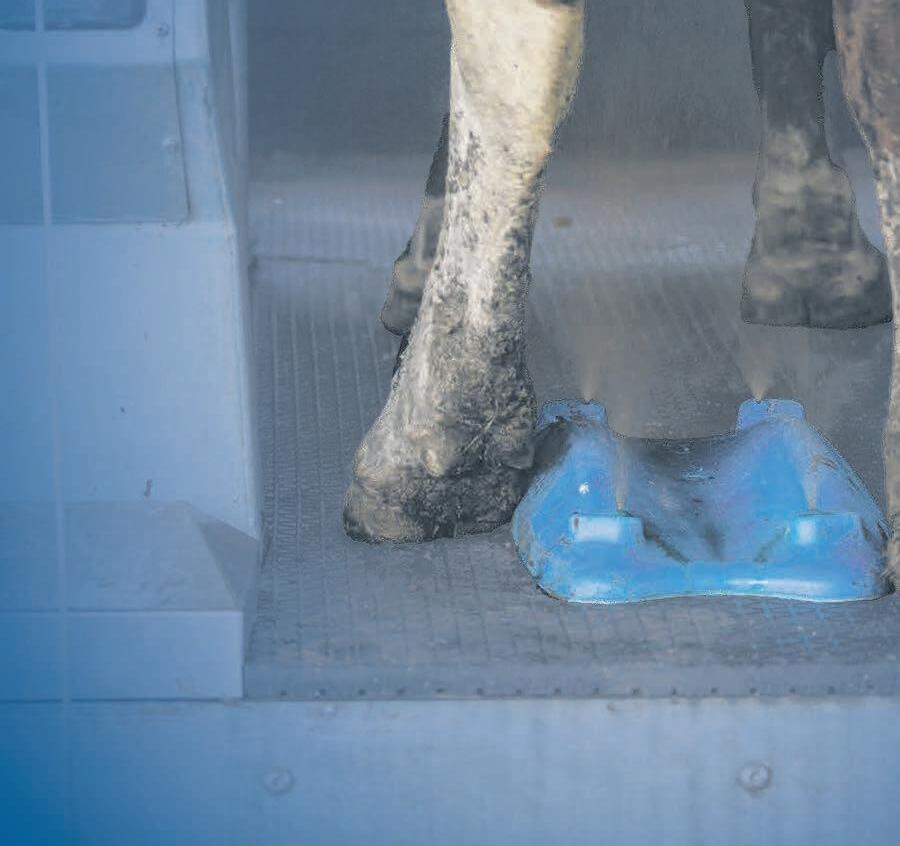




























DAIRY FARMERS from around the world
will be spreading the word about the quality of Australian Jersey cows after a successful World Jersey Conference tour.
Visitors from the United States, Canada, New Zealand, Germany, France, England, the island of Jersey, South Africa and Colombia took part in the tour across Victoria and NSW.
It was the first time since 2011 that the conference was based in Australia.
Jersey Australia general manager Glen Barrett said the conference, which started in Melbourne on April 6 and ended on April 21 at the Royal Sydney Show, had lived up to expectations.
“It has been a very successful world conference,” Mr Barrett said.
“The guests have been very impressed with the cattle they’ve seen and we’ve had some great engagement with industry facilities and
researchers.”
Mr Barrett said positive feedback about the quality of cattle had already generated international sales interest for genetics export companies.
“People were impressed with the quality of the cows and the world-leading support of the dairy industry and we are confident this will lead to more sales of Australian Jersey genetics around the world,” he said.
Mr Barrett said he was aware of a 5500-straw order and more sales were expected to be confirmed in response to the tour.
New Zealand visitors were particularly impressed with the quality of the Australian cows and the way the dairy industry functions.
“People have seen that Australia has high-quality cows and they will take the message home that they should be using more
BY GEOFF ADAMS
The Jerseys on Rohan and Graeme Sprunt’s dairy farm were under close scrutiny when the bus load of Jersey breeders from the World Jersey Conference visited. But the Sprunts are accustomed to being under the microscope, having successfully shown cattle and achieved the Australian first of holding Master Breeder status for both Jersey and Holstein cattle. Their property, near Shepparton in northern Victoria, was one of the stops on a two-week tour as part of the April conference.
The bus load of visitors included two people from the island of Jersey, the spiritual home for the Jersey breed, located between the United Kingdom and France in the English Channel.
Jersey is the largest of the Channel Islands and home to about 5000 cattle.
The breed has now spread to many countries all around the world — there are now more Jerseys in Australia than on the home island.
However, the former president of the Royal Jersey Agricultural Society, Steve LeFeuvre, pointed out there are no Holsteins on the island.
“If there are any they can’t be milked, as the processor on the island can only take pure Jersey milk,” Steve said.
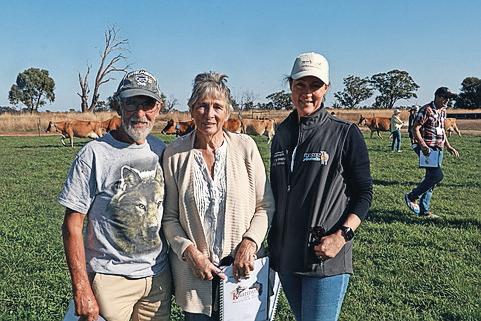
Steve lives on Jersey, but on April 16 he was in the Goulburn Valley as part of the conference tour group.
He was recalling the history of the breed while the group wandered across the Sprunts’ paddocks.
The group also visited Jersey studs in other parts of northern Victoria, as well as Gippsland, western Victoria and NSW. Each stud was asked to present their top 40 Jerseys for inspection by the visiting group.
Steve believes the Jerseys are an adaptable and profitable cow in all sorts of climatic and management conditions around the world.
“I’ve seen them all around the world
Australian Jersey genetics,” Mr Barrett said.
Jersey Australia president Geoff Akers said he was proud to recommend Australian Jerseys to breeders across the world.
“Over the past 30 years, Australian breeders sourced the best genetics from around the world and today we are very proud of the Australian Jersey that is absolutely worldclass,” he said.
Genetics Australia was premium sponsor for the tour and export manager Rob Derksen said the conference was a real success.
“As premium sponsor, it was a great opportunity to showcase Australian Jerseys to visitors from around the world,” Mr Derksen said.
“In my view, Australian breeders, through the use of the world’s best Jersey bloodlines and cow families, now have the best population of Jerseys available,” he said.

and they suit any system you put them through.
“They produce quality milk with high butterfat and protein.
“Their resilience in all conditions is remarkable. Touring around Australia, you see them in drought conditions, and their maintenance level is much less than the black and whites.”
The group was impressed by the Jersey line-up on the Sprunt brothers’ farm, which has been in the family for four generations.
The 240-hectare Kaarmona stud is managed with biological farming practices, with the aim of improving soil biology and enhancing sustainability.
A further 148ha is leased for grain and fodder.

“As the need for sustainability puts pressure on current farming practices worldwide, the efficient Jersey breed will play an important role in feeding the world in future.”
Genetics Australia hosted several international visitors for the tour, including Edgar and Lynda Brotherton from Just Milk and Roy Dixon from CRV Xeed in South Africa.
“It was beneficial for them to see Australian Jersey herds, bull mothers, cow families, farming systems and the bulls,” Mr Derksen said. Jean Macky from STNZ, as well as several NZ Jersey farmers, also attended and said the Australian Jersey had a real role to play in NZ.
“Jean was confident that as more farmers see the results of Australian Jerseys in NZ sales will grow,” Mr Derksen said.
Several of the NZ visitors ordered semen while in Australia.

The business aims to hold the herd size at about 400 cows in spring and maintain no less than 230 through winter.
The family holds the distinction of being the only stud in Australia holding Master Breeder status simultaneously for both Jersey and Holstein breeds.
They are also placed third in the Australian Breeding Values for Jersey herds. Rohan Sprunt told the visitors they had started in 1994 with 100 Holsteins and 30 Jerseys, while today’s milking herd was made up of 80 per cent registered Jerseys.
They calve down about 15 per cent in January, 35 per cent in autumn, with the balance in spring. All calves are reared at home except for 60 in-calf heifers currently out on agistment.





Demand remains strong for Australian Jersey cows with all 23 lots being sold in Dairy's Finest showcase sale on April 14.
The sale in Moama, in southern NSW, was part of the Jersey World Conference tour and averaged $4850.
Top lot of the night was Attaview Aldrin Inch 4, selling for $7500 for Reece and Toni Attenborough to Lloyd Akers from Loxleigh Jerseys.
Dairy Livestock Services auctioneer Brian
Leslie said the catalogue represented the best of Australian Jersey herds.
“Overall, we had a good result, reflecting the dry times in southern Australia,” Brian said.
“They all sold and we had a lot of interest, especially online where we had 382 logged on to the Stocklive platform watching the sale.”
Cows were sold to buyers from South Australia, NSW, Tasmania, Victoria and Queensland.
“The breeders put their best cattle forward and they should be very proud of their offerings,” Brian said.
“The buyers should be happy with what they picked up and the cattle will do a great job for them. It was an excellent catalogue and I think we’ll hear a lot more about the cattle sold in the sales.”
Brian said the top lot was a good buy.
“The Inch family is one of the emerging families in the breed and she attracted
strong competition,” he said.
There was also strong demand for semen packages with sexed semen straws selling for up to $350 per straw.
Jersey Australia general manager Glen Barrett thanked vendors for providing quality lots to support the sale.
“Jerseys are a growing breed in Australia and I’m sure the buyers will appreciate the efficiency and profitability of the modern Jersey cow,” Glen said.
WITH 17,000 dairy cows across 15 farms under their Just Milk banner, South African farmers Edgar and Lynda Brotherton are looking to Australia to boost the quality of their herd.
With one of the largest herds in South Africa, Mr Brotherton wants to stabilise numbers but increase milk production through genomic testing and selective breeding.
Mr Brotherton was hosted by Genetics Australia to join the World Jersey Conference tour presented by Jersey Australia from April 6 to 21, and addressed a sponsors’ breakfast in Warrnambool.
He was joined by Roy Dixon from CRV Xseed Genetics, the exclusive distributor of Genetics Australia’s Jersey semen in South Africa.
“The main purpose of our visit to Australia is to visit breeders of the bulls we’ve used,” Mr Brotherton said. “It is our intention to use more Australian genetics and it has been fantastic to meet the breeders and put faces and names to the bulls we use.”
Just Milk is a management company based in the Eastern Cape that manages dairies. The milking herd comprises 17,000 cows and the total herd size including calves is 25,500. Just Milk also has cheese processing facilities, partnerships with piggeries and runs a small beef operation.
Just Milk is a unifying brand, not a single corporate entity. It operates on farms with various land ownership and profit-sharing structures.
“We personally own some of the properties, 50 per cent share in some and 25 per cent sharefarmers in others,” Mr Brotherton said. “This model allowed land investors an opportunity to gain exposure to dairy farming.”
Very few animals have been brought into the herds from outside, resulting in selective breeding and an optimal animal suited to the Eastern Cape conditions.
Mr Brotherton says his interest in Australian

genetics stems from the similarities between the two countries’ farming conditions.
“We’ve got low rainfall areas with irrigation that can have temperatures up to 40 degrees for five to six days in a row, and we’ve got coastal farms like Gippsland with rolling hills and dryland farming.”
During their growth phase, Just Milk reared about 1000 surplus heifers every year to be on standby for new projects.
“At that stage due to growth, we weren’t able to be too selective with the heifers we put into the system,” Mr Brotherton said. “That’s changing now because we’ve decided we’ve reached our cap.
“Although I enjoy building new dairies, at my age I don’t think we will do any more and will probably cap numbers and look to process more of the milk we produce.
“We’re looking at the option of genomic testing our heifers and being more selective.

Prebiotics&Probiotics to aid digestionandgutmicrobialbalance (15 billion CFU per 10 gram dose)
The aim will be to get more milk out of the same number of cows, rather than add more and more cows.”
The Just Milk cow originated from a black and white herd crossed to Jersey after Mr Brotherton toured New Zealand in 1995.
“We started using New Zealand-bred Jersey bulls like Manhattan, Maunga, Murmer, Presley, Nucleus and Kingpin, especially Manhattan,” he said.
“One of the reasons we chose the New Zealand bulls was that the black and whites we had been milking were too big. We figured the smaller New Zealand Jersey would bring them down quickly and they certainly did that and they bred us a very good cow.”
They then moved to Genetics Australia through supplier CRV.
“Some of the older bulls that worked very well for us included Badger, Tahbilk, Aussiegold and more recently Stark, Ventura,
Goldband, Bedford and other genomic bulls,” Mr Brotherton said.
“It has been very nice here in Australia to see some of the mothers and daughters of the bulls we’re using and we were very impressed with what we’ve seen.”
They have also used some US genetics — Valentino, Matt, Lemonhead, Oliver P, Stoney and Starlord — to get more milk into the cows and they have served that purpose.
“Now we will settle into more Australian genetics,” Mr Brotherton said.
“What we’ve found is that the Australian system is about as close to our system as we can get. It is largely grass-based with supplement and concentrate in times of shortages.”
The Just Milk farms have a 12-week calving period in spring, eight weeks in autumn. Heifers calve down at 24 months, mostly using sexed semen.
They sell some heifers because of a lack of space and also lease surplus heifers for a monthly rental.
The South African dairy industry has changed significantly since Mr Brotherton began farming in 1986. In 1997 there were 7000 dairy farmers, that has been reduced to 882, though farms are bigger and production has increased.
The total herd population is 30 per cent Holstein, 27 per cent Jersey, combined herds running both Holstein and Jersey 23 per cent, crossbreds 16 per cent and Ayrshire four per cent. Most of the 3.65 million litres of milk (86.1 per cent) is produced around coastal regions and long-life UHT milk and cheese are the main markets, with the fresh milk market decreasing.
ɋ Adding pigs and cheese production to the mix has been the cream on top for Edgar and Lynda Brotherton’s dairy business in South Africa. See the June issue of Dairy News Australia for the full story.
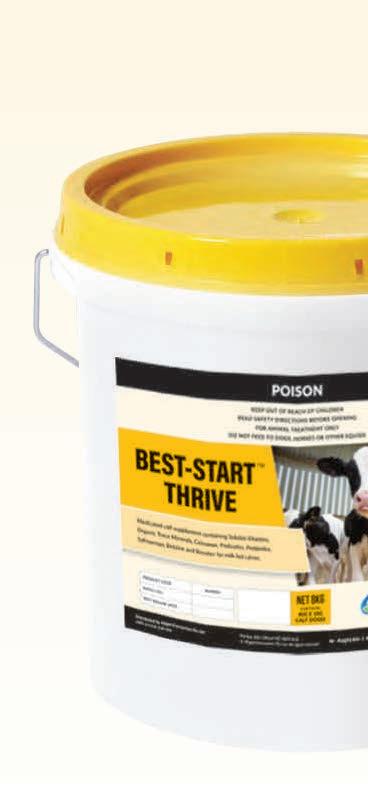





BY GEOFF ADAMS
FONTERRA AUSTRALIA and Burra Foods have both increased their milk prices.
On April 10, Fonterra advised its Australian suppliers it was increasing the minimum milk price by 20¢/kg of milk solids, comprising 17¢/ kg butterfat and 24¢/kg protein.
This takes the weighted average milk price to $8.35/kg MS.
On March 26, Burra Foods announced a $0.10/kg MS step-up to its milk supply partners for the period July 1, 2024 to June 30, 2025.
This takes the Burra Foods milk price range for FY25 to $8.10/kg MS to $8.60/kg MS.
In a letter to milk supply partners, Burra Foods CEO Stewart Carson said “like the GDT,
demand and pricing for our fat products has improved, whilst protein products have continued to be underwhelming”.
Despite increasing global volatility, Mr Carson said demand in core international markets is stable, while China is still uncertain as local milk volumes exceed demand.
He acknowledged the tough seasonal conditions impacting many of Burra’s suppliers and the stresses this can bring.
Fonterra Oceania’s farm source and sustainability director Matt Watt said it was Fonterra’s commitment to farmers to pass on market improvements.
“In recent months, global market conditions have held and continued to show signs of improvement,” Mr Watt said.
“While current uncertainties in the global economic and trade environment remain, and
For farming couple Merv and Mary Williamson, winding up their milking herd when they were approaching their 90s might seem a logical thing to do.
But, although they have shipped off their last milkers (after 66 years of milking) from their Whittlesea property, they haven’t finished with farming.
Merv, 89, is raising a new herd of Holstein steers on the 121-hectare farm, just north of Melbourne.
He travels to Shepparton to buy the calves and grows them out for sale to
there is potential for disruption, the softer Australian dollar has enabled improved returns on some of our export exposed product, supporting this step-up.”
The Victorian Farmers Federation United Dairyfarmers of Victoria welcomed Fonterra’s step-up in farm gate milk prices as a positive move for suppliers.
But the VFF UDV cautions that prices remain below global benchmarks and highlights the continued need for robust protections under the Mandatory Dairy Code of Conduct.
VFF UDV president Bernie Free said the additional support provided by Fonterra would be welcomed by farmers facing rising input costs, dry conditions and ongoing market volatility.
“It’s important to recognise that even with this step-up, farm gate prices are still lagging
Greenhams abattoir.
“We raise them for about three years. The Holsteins grow out really well,” Merv said.
He’s got more time, so he is catching up on a few things he’s been meaning to attend to for years, like fencing.
Their decision to cease milking in 2021 marked a symbolic end for the couple and for their community.
Although the farm was with the same family for 116 years, they were the last dairy farm in the Whittlesea area, which is now

largely occupied by either suburban development or larger, lifestyle residential properties. Their decision was acknowledged by the Floridia Cheese company in Thomastown, who had processed their milk supply for more than 20 years.
Mary, 91, said the cessation of milking required some adjustment to their routines after 66 years, and she has taken up volunteer sewing for the Olivia Newton John cancer hospital to occupy her free time. She’s made 137 pouches for chemotherapy patients.
behind what we’re seeing internationally,” Mr Free said.
“While the global dairy market has shown some signs of recovery, Australian producers continue to face unique pressures, including escalating energy and feed costs, labour shortages and weather extremes.”
Mr Free said the announcement also reinforces the critical importance of the Mandatory Dairy Code of Conduct, which establishes clear rules around milk supply agreements and ensures farmers are treated fairly in negotiations.
“The dairy code plays a key role in restoring balance to the dairy supply chain,” he said.
“It helps safeguard producers from unfair contract terms and gives them more confidence when making investment and production decisions.”
While most of the dairy cattle have long since left the Whittlesea property, there is one cow who won’t be going.
The Holstein cow, known as Em Jays Ice Hilda, classified 91, will be seeing out her days on the gentle slopes of the Williamson farm.
They couldn’t bear to part with the loyal old girl, who is 18 years old.
“She’s a good old cow,” Merv says with affection.
“Never had mastitis, just a bit prone to milk fever.”





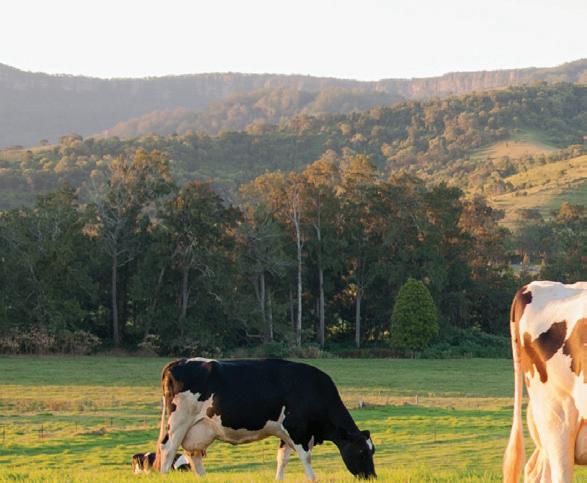
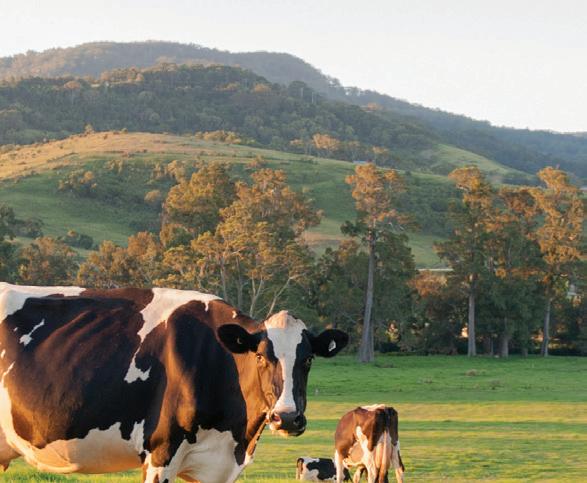



Winter and spring are vital months for balancing pasture growth and providing quality feed for meat and milk production.
Sumitomo Chemical Australia Pty Ltd has trialled ProGibb SG in commercial situations since 2004 demonstrating increases in grass pasture production can be achieved during winter months.
ProGibb SG applied to pasture during winters coolest months will stimulate pasture growth and increases dry matter per hectare with no loss of feed quality (megajoules ME per kilogram of dry matter).

Scan here to see more information about ProGibb SG

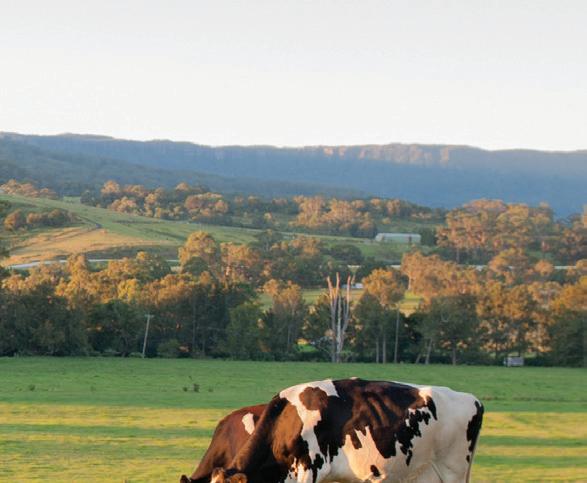




• ProGibb SG increases Dry Matter per ha.
• ProGibb SG increases carrying capacity.
• ProGibb SG reduces supplementary feeding.
• ProGibb SG increases profitability from pasture.
• No withholding period and no residues in either meat or milk.
• ProGibb SG can be utilised in all pasture based systems including fat lamb, beef, dairy, equine, deer and goat operations.





FARMERS FROM Gippsland and north-east Victoria have been added to the Jersey Australia Master Breeder honour board, while the breed’s first Emerging Breeder has been announced.
Darryn Hourigan’s Darrynvale Jerseys from Milawa in north-east Victoria and Trevor Saunders and Anthea Day’s Araluen Park Jerseys from Shady Creek in Gippsland were announced as Jersey Australia’s new Master Breeders at a dinner on Sunday, April 13 in Melbourne.
Jersey Australia also revealed Rodney and Stephanie Goode from Boronia Ridge Jerseys at Poowong North in Gippsland as the inaugural Emerging Breeders.
The Master Breeder awards were introduced in 2023 to recognise breeding excellence over the past 20 years and the commitment of farmers to the breed.
The award requires breeders to have been a member of Jersey Australia for at least 20 years and to register 25 animals a year on average across those 20 years along while producing elite brood, type and production cows and elite bulls.
The Emerging Breeder award introduced this year is based on 10 years’ continuous membership, registering at least 100 animals a year under the breeder prefix, breeding two or more cows scoring 90 or more in classification, breeding at least two cows that produce more than 3000 kg/ MS, and the breeder must have started genomic testing.
Jersey Australia board member and chair

of promotions Jane Sykes said the Emerging Breeder award aimed at encouraging and recognising younger farmers advancing the breed.
“The greatness of a Master Breeder does not happen overnight; it takes time and patience,” she said.
Stephanie Goode said she developed a love of Jerseys from her parents and bought them into Rodney’s herd.
“We will keep on trying and hopefully continue to get better and better,” she said.
Darrynvale Jerseys was established in 1970 and is owned and operated by Darryn Hourigan, his partner Rochelle and Darryn’s son Bailey and daughter Ellie are also involved in running the farm.
It has registered 2888 cows and has had 351 classified as excellent.
Darrynvale is a platinum production herd and regularly achieves more than 7000 litres average,
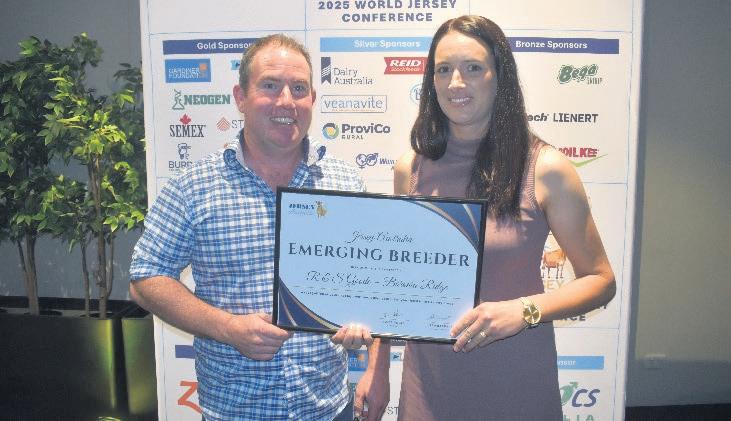
with some cows producing up to 11,000 litres.
In the early 1980s, Darryn’s father Keith invested in Big Hollow and Merriland genetics in New Zealand, including the world-renowned Daisy family, which has had an enormous influence in the herd.
Darryn continues to breed award-winning cows with deep pedigrees.
Trevor Saunders and Anthea Day, both fourth generation farmers, purchased their farm at Shady Creek in 2004, and combined the best from their separate herds to move forward as Araluen Park.
They also incorporated the Stony Run stud prefix into their herd.
Araluen has registered 2757 cows and produced 366 excellent cows.
It has multi-Australian generationally-bred cow families from the United States, Canada, New Zealand and Australia.
THROUGHOUT MAY, eastAUSmilk will be conducting dairy discussion dinners across Queensland and NSW to chat about farm business resilience planning, milk pricing and contracts.
These discussion dinners will be beneficial to farmers across the two states leading up to the release of Milk Supply Agreements on June 1.
The meetings will be led by Matt Hall, Eric Danzi and Jade Chan.
Matt has more than 25 years experience in the dairy industry, having worked predominantly in the Gippsland region of Victoria. He has previously worked for milk processors and has an in-depth knowledge of milk price and contracts to provide support to eastAUSmilk dairy farmer members.
The discussions will be robust, focusing on market exposure and pricing agreements however the topics can be driven by demand and interests on the night.
Workshops are through the Farm Business Resilience Program with additional discussions around business planning, preparedness around disasters and learnings from the Finley Farm Tour.
ɋ May 19 to 23: Darling Downs, Southern Burnett and Scenic Rim regions.
Workshops focusing on milk price and contracts.
ɋ May 7: Blighty Pub, 2371 Riverina Hwy, Blighty at 6.30pm.
ɋ May 12: Nowra: Worrigee Sports Club, 131 Greenwell Point Rd, Worrigee at 6.30pm.
ɋ May 13: Jamberoo Bowls Club, 11 Allowrie St, Jamberoo at 6.30pm.
ɋ May 14: Bodalla Pub, 73-77 Princes Hwy, Bodalla at 6.30pm.
ɋ May 27: Singleton Diggers, 49 Castlereagh St, Singleton at 6.30pm.
ɋ May 28: Roundabout Inn, Church St, Gloucester at 6.30pm.
ɋ May 29: Club West, Edinborough Dve, Taree at 6.30pm.
Two additional meetings for southern NSW are in the works, with dates and locations to be announced. And venues are still being confirmed for the Queensland meetings.
ɋ Go to the eastAUSmilk website, newsletter or Facebook page for updates on locations and dates.















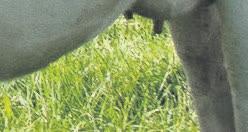




























� inner body temperature (± 0.01 °C)
� drinking cycles and water intake with TruDrinking™
� rumination with TruRumi™
� heat detection including insemination window
� abort detection
� calving prediction (~15h in advance)
� feeding tool with ration groups
� optional: pHmeasurement
BY JEANETTE SEVERS
SINCE LOSING topsoil after laser grading a paddock in 2019, Peter Neaves and Kate Mirams have been on a journey to improve their soil and farming systems to farm more sustainably.
They used to apply nitrogen on their pastures at a rate of 200kg/ha, and have since reduced that to 29kg/ha.
They are still growing 12 tonnes/ha DM of pasture.
They received the 2024 Lyrebird Award from West Gippsland Catchment Management Authority for their environmental sustainability efforts, that have included protecting waterways and a lagoon on their property and reducing nutrient run-off, while managing a profitable dairy farm.
“We have lots of lagoons and waterways, and we’ve planted native trees and vegetation for shade for the cows and to provide a filter for water that leaves the farm,” Peter said.
There are soil moisture probes scattered across their flood-irrigated farm, to measure how much water is used on farm.
Peter and Kate milked a spring calving peak of 322 cows in 2024, on their dairy farm at Newry, in the Macalister Irrigation District in Victoria.
Following conventional farming practices, Kate and Peter planted monoculture winter and summer crops, fertilised by granular urea, superphosphate and potash.
Their herd’s winter grazing was dependent on annual rye-grass, with a summer crop of millet followed by perennial rye-grass and clovers.
In recent years, they have shifted their focus to implementing regenerative farming practices, with more than 50 per cent of their farm now growing multispecies pasture varieties.
Peter and Kate are involved in a five-year pasture trial program on their farm, comparing regenerative and conventional farming techniques, supported by Agriculture Victoria and West Gippsland CMA.
Funding for the trial project began in 2019, and will run through to June, 2026.
Agriculture Victoria field staff have harvested and measured dry matter yield on the trial plots.
Feed tests and soil tests down to 60cm have also been incorporated.
A Soilkee comparison was part of the initial program, but has since been dropped.
Kate said the narrowness of the irrigation



bays affected the effectiveness of using a Soilkee comparison.
“The bays developed ruts and the pasture grew well, but the ruts put us off,” Kate said.
Kate and Peter have stopped cultivation in their trial paddocks.
They have stopped using fungicides and pesticides on seeds, and reduced heavy applications of nitrogen and combined nitrogen, phosphorous and sulphur.
Kate and Peter are incorporating multispecies crops and perennial pastures into their grazing mix, with nutrient applications guided by soil tests and healthy soil biology.
They have planted chicory and plantain to loosen the deeper soil profile, encouraging plant roots and water to spread deeper, as part of their focus on regenerative farming.
Prior to sowing regenerative pasture, Kate and Peter add microbes, worm exudate and trace minerals to seed.
To encourage plant growth, they are using soluble fulvic acid powder as a foliar spray and as a carbon source to plants and the soil when they are adding a nitrogen fertiliser.
Peter and Kate are also using a soil drench, and incorporating boron, fish hydrolysate, and potassium sulphate.
Lime and gypsum have been incorporated into their farm’s soil where appropriate.
“In October 2019 we sowed an annual multispecies blend of summer species, followed in March 2020 with a multispecies winter blend,” Kate said.
“Then in October 2020, we sowed again with a 10 species summer blend, and then March 2021 with an eight species annual blend.
“We were trying to get the maximum value from what annual plants will do for helping the soil.




“The following year in March, we topped up with a bit more perennial multispecies.
“In March 2023 we sowed clovers. March 2023 is the last time anything was sown in the multispecies plots.”
The conventional pasture bays began with a crop of oats in 2019, followed by millet in summer and Italian rye-grass in winter.
Millet was sown again the following summer, followed by a mix of Matrix and perennial rye-grass and some clovers. Matrix was also oversown more recently.
Paddocks used for conventional farming continue to incorporate an N/P/K mix and pasture booster.
“In 2023 we fertilised at a rate of 20 kg/ha, and this year we’ve applied 29kg/ha,” Kate said at an on-farm field day in late 2024.
There were also two floods across their land in the same period.
Kate and Peter have measured more dry matter tonnage per hectare is consumed by the cows on the regenerative multispecies plots, compared to paddocks farmed conventionally.
The difference is as much as 1.3 tonne/ ha DM.
In comparison, the cost of dry matter tonnage consumed has been lowest on their paddocks of regenerative multispecies pasture, almost $1/tonne DM behind those farmed conventionally.
The middle of spring shows little difference across the pastures, when measuring crude


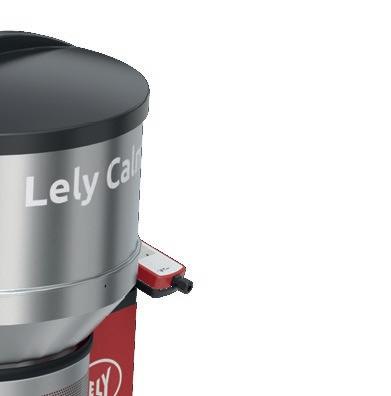



protein, energy and acid detergent fibre.
However, ADF is consistently highest in the regenerative pastures when measured across a year (July 2023 to June 2024).
“I would say that the feed test is far more variable over time on the multispecies pastures,” Kate said.
They have been able to lengthen plant recovery time between grazings.
In a comparison with eight other farms in the Macalister Irrigation District, all of them high users of N, Kate and Peter have almost eliminated N application on their farm.
Their pasture consumed as tonne DM/ha is still up with the highest producers in their district.
Production has also increased over the past five years – by about 40,000 kg MS.
Some of the questions that need answering as the project continues include if pasture production will be maintained or slow down as the perennial varieties age, and if pasture density will be changed as the multispecies age.
At the moment, bare patches of ground have been minimised across the farm.
Peter and Kate are also keen to incorporate measuring the carbon profile and biodiversity of their farm system; and to better utilise their soil moisture probes.
Peter and Kate have spoken about their journey at gatherings including the Grounds for Growth 2025 conference, held at Warrnambool in March this year, and the couple has hosted on-farm discussion groups.

Reduce the breeding period and stimulate the calf’s development into a strong, healthy and highyielding cow with the Lely Calm. This automatic feeder supplies milk at the right temperature and provides insights into the milk intake of each calf. Find out more on lely.com
Bright farming is yours by choice

BY JEANETTE SEVERS
PETER NEAVES and Kate Mirams are dairy farmers on a farm abutting the small town of Newry, in the Macalister Irrigation District, Victoria.
About 135 hectares of their property is for the dairy farm, with 110 ha grazed as the dairy platform.
The balance of the property is given over to vegetation reserves, a lagoon, waterways and creek.
Peter and Kate also have a 59 ha outblock, which they took on recently, for raising replacement heifers.
“We irrigate about 206 ha across the two farms,” Peter said.
About 24 ha is irrigated with a K-line system, and the majority of the farm is graded into bays for flood irrigation. The home farm is flat.
Peter said the flat land created a problem, because without fall, it was difficult to get irrigation water to extend to the bottom of the bays.
“We’re in the process of developing that irrigation through a new pipe and riser system,” he said.
“But we’ll keep the flood system, because I like the idea that essentially I’m using gravity to water my paddocks.
“There’s no fuel cost, no burning fossil fuels or anything to deliver water to the paddock.”

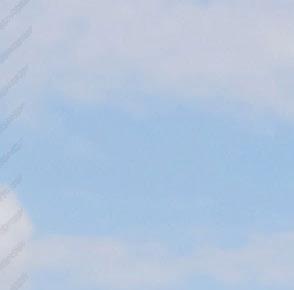




The couple is investing in a turkey nest dam to be able to hold water so they can irrigate offline.
Recent government investment in modernisation of the irrigation infrastructure in the Newry-Tinamba district saw open channels on multiple farms changed to a pipe system, decreasing leakage and evaporation.
It also improved gravity flow of water from Lake Glenmaggie throughout the system.
It has provided more security for how Peter and Kate farm on their dairy properties.
The irrigation system extends from August 15 to May 15.
“The modernisation of the irrigation system has guaranteed supply, so if I order 12 megalitres, I’ll get 12 Ml,” Peter said.
“Before modernisation, there was no guarantee you were getting what you ordered — if I ordered 12 Ml I’d get eight. It would take a good hour for water to get on the bay, and there’d be leaks and evaporation [along the channels].”
Peter and Kate also favour a combination of flood and pipe and riser irrigation, because the lay of their land, with many old trees among the vegetation, prevents the use of a pivot.
“We’re looking now at our water use efficiency, monitoring how much water is going to each bay, and how much we













can spread the waterings out,” Peter said. They have soil moisture probes scattered across the farm.
“They’ll help us get a pretty accurate picture of what water is soaking in, and we can measure how much water is leaving the farm in run-off,” Peter said.
The effluent pond is also shandied and waters about 20 ha of land.
Peter said taking on the outblock meant he and Kate increased the herd size in the past year, by milking through cows that were empty but didn’t dry off, and, in

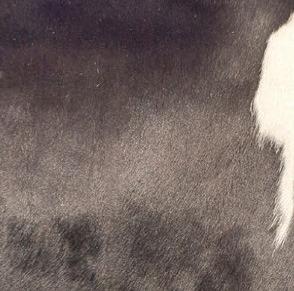








particular, keeping more heifers.
They were also able to increase milking numbers because the irrigation modernisation project brought 10 ha more of their country into production.
In spring last year, Peter and Kate were milking 322 head, after spring calving.
The herd is milked twice a day in a 15-double-up herringbone dairy, with stall gates.
“Production is pretty consistent yearon-year,” Peter said.
“In 2024, we were able to take on 10 more heifers than previous years,” Peter said.
“We brought more of our heifers into the milking herd and didn’t calve down as many cows.”
The milking herd is a mix of crossbred-Holstein cows, and joining is through artificial insemination over six weeks, followed by bulls for three weeks. The herd is spring calving.
Peter and Kate have used beef over their dairy heifers in the recent past, and have returned to using dairy semen for all joinings.
“We’re currently using Jersey bulls,” Peter said.
“With the semen for AI, we’ve got a mix of Holstein, Jersey and Red breeds.
“The semen is about 70 per cent Holstein.
“The second round of AI is done with short gestation semen.”
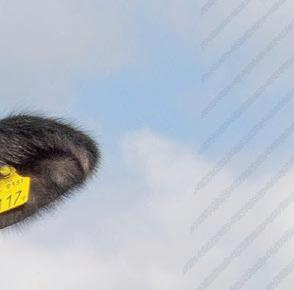



























There’s a lot of pressure to optimize milk and component yields. MFP® Feed Supplement delivers methionine, essential to milk and component production, with additional rumen activity to help fight milk fat depression. Developed by intelligent nutrition in a dry, granular form, it’s ideal for premixes, feed mills, and local co-ops. Produce milk that’s made of more. Start feeding solutions at novusint.com
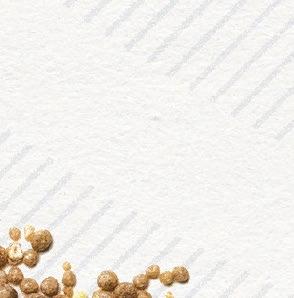





















BY JEANETTE SEVERS
AUSTRALIAN FARMERS were waiting on the federal election outcome before they made machinery purchasing decisions.
The May 3 poll was after Dairy News Australia went to print, but both major parties had committed to extending the instant asset write-off for equipment purchased for business use, albeit with differing value limits.
The trade tariffs announced by United States President Trump were also impacting global sales.
These were the views of machinery and equipment stockists at Farm World, held at Victoria’s Lardner Park in late March.
Matt Peeler, representing European machinery manufacturer Kuhn, and Shane Marshall, of TTMI Maffra, were sharing an exhibitor site at Farm World.
They spoke to Dairy News Australia about current issues affecting sales.
The election outcome, and therefore the future of the instant asset write-off program — along with a growing uncertain global market for Australian product — have affected purchasing decisions in the first few months of 2025.
“Machinery and equipment sales were really good up until Christmas, but then it’s backed off,” Shane Marshall said.
He said everyone was waiting on the election before they made decisions for their business.

Shane said livestock producers were also waiting to see any effects of potential changes to the live animal export market.
Matt Peeler said manufacturers were waiting for the election result and for government policies to stabilise post-election, because the global markets were unstable.
He said increasing export tariffs for countries into the US, designed to boost manufacturing within the US, were having a flow-on effect to global markets.
“As a European manufacturer, the increased export tariff into the US and into

Canada, is affecting Kuhn and other companies,” Matt said.
“For Kuhn, the North American dealer network are family dealerships. They supply equipment and machinery into Canada, and those businesses are being affected negatively by the new US tariffs.”
Matt said that European manufacturers, unable to sell into the US farming market, are looking for other places to export their product.
Australian farmers, part of the expanding Australasian farming sector, may benefit from
greater competition for market placement from these manufacturers.
Matt said the North American dealerships realise they will have long wait times for equipment and machinery manufacturers within the US to scale up their businesses.
The supply chain flow-on effect will have wide ramifications for farmers and suppliers and, at the other end, consumers.
“Anyone who manufactures product in Europe and sells into America is being affected,” Matt said.
In 2024, the Albanese Government committed to a one-year extension (to June 30, 2025) on the $20,000 instant asset write-off for small and medium businesses, including farm businesses.
According to the Australian Tax Office, the $20,000 limit applies on a per asset basis, so small businesses can instantly write off multiple assets.
The ATO advises that businesses can also acquire a pool of assets valued up to $20,000 that can be depreciated quicker and over fewer years than more expensive assets.
In its pre-election promises, Labor committed to extending this program for another year if it is re-elected.
The Liberal party, in its pre-election promises, committed to a potential permanent $30,000 asset write-off program.
Any extension to the instant asset write-off program will be a boon to businesses along the supply chain, although most farm machinery costs more than $20,000.
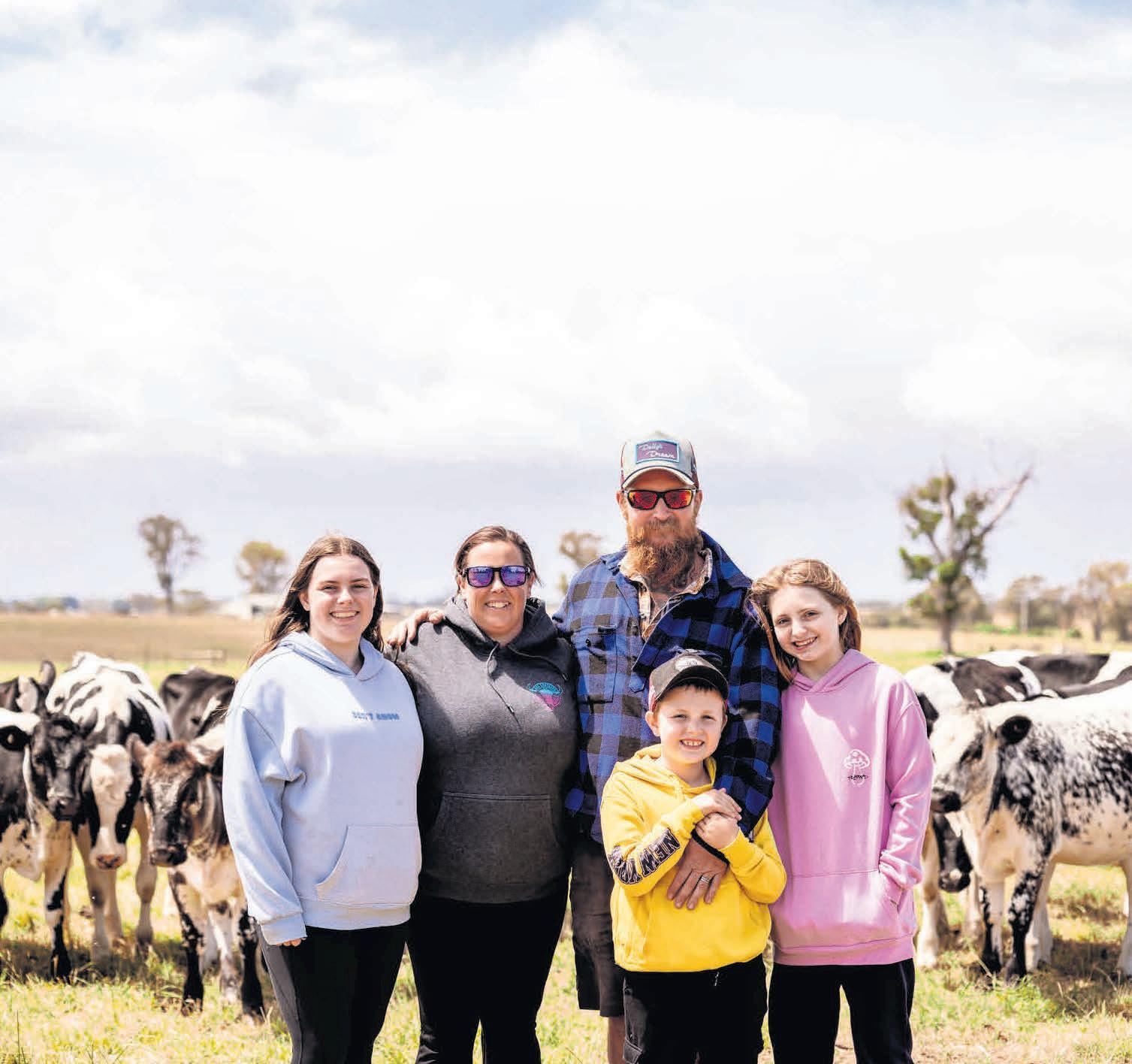

VICTORIA’S DAIRY regions are facing growing challenges in accessing housing, affecting workforce attraction and retention and threatening the long-term sustainability of the state’s $3 billion dairy industry.
To address this critical issue, the Gardiner Foundation is launching an Expression of Interest process to identify innovative housing solutions for Victoria’s dairy regions.
The foundation is seeking partnerships with developers, investors and government bodies to create sustainable and affordable housing options for dairy communities. Gardiner Foundation general manager Jenny Wilson said access to housing was a major barrier to attracting and retaining a skilled workforce in Victoria’s dairy regions.
“Across the dairy and broader agricultural sector, workers are struggling to find affordable accommodation, putting pressure on businesses and regional economies,” Ms Wilson said.
“By working together on practical, long-term housing solutions, we can help ensure the sustainability of our dairy industry and the strength of regional communities.”
The foundation said key challenges included severe housing shortages (limited availability in both rental and ownership markets); rising rental costs (pushing workers out of affordable accommodation);
and barriers to home ownership (rapid price increases make it unattainable for many).
The shortage of affordable accommodation is placing pressure on dairy businesses, processing companies and the broader service sector, the foundation said. Many businesses are shouldering the financial burden of providing housing for workers, further limiting industry growth.
George Housakos from Cushman & Wakefield, who has been appointed to conduct the EOI process for Gardiner Foundation, said affordable housing was essential for community sustainability.
“Gardiner Foundation’s initiative to support innovative housing solutions in Victoria’s dairy regions will not only encourage much-needed housing, but aims to stimulate local economies and foster community development,” Mr Housakos said.
“We anticipate strong interest from different stakeholders in the housing system, all eager to address the housing shortage in Victoria’s dairy regions.
“This collaborative effort will be crucial in delivering sustainable and innovative housing solutions that benefit the entire community.”
The EOI process is now open to stakeholders with ideas to deliver sustainable housing solutions in Victoria’s dairy regions. All inquiries can be directed to: housing@gardinerfoundation.com.au


BY SOPHIE BALDWIN
AS FARMERS continue to face an unprecedented drought, the worst in living memory, the South Australian Government has increased its support for the struggling sector with a $55 million package.
Unveiling the measures on April 8, SA Premier Peter Malinauskas declared the government “cannot make it rain, but we can take practical action to support our farmers”.
The decision has been welcomed by the South Australian Dairyfarmers’ Association.
SADA president Robert Brokenshire said the dairy industry was facing drought conditions which are not only the worst in living memory for many farmers, but the worst in the memory of their parents and grandparents.
“As we face these multi-generational challenges we welcome the considered support now offered by the South Australian Government,” Mr Brokenshire said.
He said farmers will continue to produce milk and maintain the health of their animals.
“During this drought, dairy farmers across South Australia are committed to the provision of milk of the highest quality to meet the daily nutritional needs of all South Australians, while we remain mindful of the wellbeing and welfare of our cows.”
Mr Brokenshire said last year’s spring break was practically non-existent with frost, cold weather and no rain halting pasture growth and shutting the season down to just a short and unproductive 12-week window.
And at this stage autumn is not looking much better.
Mount Compass dairy farmer Warren Jacobs said a dry winter, spring and autumn had meant an extra reliance on their 65-hectare irrigated area.
He said the family and business were trying to be positive, and dry seeding and fertilising in the hope of a good season ahead.
“We have had to buy a lot of hay this season which has been expensive and eroded some of our profit,” Mr Jacobs said.
“The cooler weather has helped but we are still waiting for a break and are anxious about what the coming year will bring.”
On-Farm Drought Infrastructure Grants announced in the initial $18 million package in November have been well received by dairy farmers, and SADA welcomed the extension of this program for rebates that assist with projects to manage drought conditions and strengthen drought preparedness.
“We also welcome the commitment to an immediate and comprehensive strategy to boost mental health and resilience in drought-affected areas,” Mr Brokenshire said.
He thanked SA Primary Industries and Regional Development Minister Clare Scriven.


“The minister has remained in close contact with SADA’s concerns and we acknowledge her efforts in advocating on behalf of agriculture to the premier and cabinet to enable this package.
“SADA will work with our members to ensure that all dairy farmers are engaged with the new government package.”
Mr Malinauskas acknowledged that since the initial $18 million package was released in November, “things have got worse”, particularly for the state’s $18.5 billion primary industries and agribusiness sector.
“The package I announce today ... includes immediate financial relief for those doing it toughest, significant mental health supports, and support for wider regional communities and businesses,” he said.
The package has been designed in direct consultation with primary producers, including a round table with farmers and key industry bodies.
THE SOUTH Australian Dairyfarmers’ Association has welcomed the announcement that farmers impacted by the collapse of Beston Global Food will receive financial support through a South Australian Government assistance program.
SADA will administer the program in line with government expectations to help farmers left out of pocket re-establish themselves and grow.
The grants will be available to dairy farmers listed as creditors in the Beston liquidation process, to enable them to invest in farm modifications, pay invoices or accounts, or reduce working capital debt facilities.
Primary Producers SA chair Simon Maddocks said the government had listened to the concerns of primary industries and rural communities.
“These targeted measures will deliver much-needed, comprehensive support to farming families and rural communities, helping to ease the economic and social pressures caused by the prolonged drought affecting much of the state,” he said.
New assistance measures in the package include:
ɋ A further $13 million for On-Farm Drought Infrastructure Grants for rebates that assist with projects to manage drought conditions and strengthen drought preparedness.
ɋ An additional $4 million to assist charities with freight costs to transport donated
SADA president Robert Brokenshire said SADA will work with affected milk supplier to submit a plan for how they intend to utilise the funding to support each business’s requirements.
“We appreciates the understanding and support the state government has shown,”
Mr Brokenshire said.
“The state government is committed to a strong dairy industry as outlined in the SA Dairy Industry Action Plan 2024-2029 and this support to those Beston farmers is paramount to the sustainability of the billion dollar SA dairy industry.

fodder to assist farmers with feeding livestock.
ɋ Immediate financial relief by providing rebates for emergency services levy and commercial vehicle registration fees for primary producers receiving the Commonwealth’s Farm Household Allowance.
ɋ $2.5 million for an immediate and comprehensive strategy to boost mental health and resilience in drought-affected areas.
ɋ $1 million for Rural Financial Counselling Support.
ɋ A further $250,000 for grants of up to $5000 for the Connecting Communities Events Program, for groups to host events that foster social connections and provide support.
ɋ $17.4 million for Future Drought Fund Preparedness and Resilience programs. – with AAP.
“The Beston farmers have had a double whammy, with the impact of a severe drought like all other farmers, but further complicated by not receiving significant milk payments for milk they had produced.
“This will help them to get through a very tough situation and also be able to pay creditors in the regions that have been waiting many months for their payments of goods supplied to those farmers.”


BY SOPHIE BALDWIN
THERE ARE two sides to Casey Treloar’s career and she happily balances both.
First, there is her career as a popular news reporter and presenter for Channel 7 in Adelaide, but secondly, and just as important, is her career in the dairy industry, which has led her to places she never would have thought or dreamed of prior to study.
Growing up on a dairy farm instilled in Casey a lifelong passion for dairy and, in particular, showing cattle, and despite the sale of the family farm, Casey has continued to breed and show cattle under her prefix Finesse Genetics.
She is also the face of Around the Barn, a live video broadcast on social media that has taken International Dairy Week and the Australian dairy industry to the world.
The inspiration for ATB began after COVID-19.
Declan Patten had just taken over the running of IDW in 2022, and was looking for ways to tap into the market and boost the profile of the event.
And ATB has certainly done that, as year-after-year, the popularity has grown along with
Dairy industry leaders are travelling Victoria to give their insights on boosting productivity and sustainability.
“Dairy farmers and those in the associated industries supporting dairy are invited to attend Appetite for Success, a series of events focused on increasing dairy productivity, sustainability and profitability,” Pioneer Seeds dairy specialist Greg Morris said.
The events will take place in Shepparton on Thursday, May 15, Sale on Monday, May 19, Inverloch on Tuesday, May 20 and Warrnambool on Thursday, May 22.
Farmers, dairy consultants, agronomists, nutritionists, resellers and contractors will come together to hear from keynote speaker, Pioneer Global nutritional sciences manager Bill Mahanna.
Dr Mahanna will share his wealth of knowledge in dairy nutrition and management, gained from working hands-on with dairy farmers around the world.
“Bill is renowned, and especially regarded for, his ability to provide insights into actionable opportunities and his personal and thorough approach to the whole dairy farming system,” Pioneer Seeds dairy specialist Leighton Hart said.
Dr Mahanna has 38 years of experience at Pioneer and is an adjunct professor in the Animal Science Department at Iowa
the reach, not just across Australia, but around the world.
Casey interviews IDW winners and exhibitors across the five days of the event, capturing all the emotion and joy.
“ATB has helped draw the emotion out and has helped create a side to showing the wider public has never seen or been exposed to before,” Casey said.
It is all systems go once the event kicks off.
“I am always watching the show and keeping an ear out for any interesting stories from the sidelines and assembly area, knowing the breeders and the pedigrees also helps.
“If I see a good cow come along, and I don’t know her, I will look her up and learn about her, often the story of new owners or where she came from is the coolest part.
“I often have to think on my feet, and it certainly helps to be prepared and know the background pre-interview.
“The last two years we have had a media intern come on board, which has been so much better than grabbing someone from the sideline to help, and it has been beneficial to enable us to tap in to more social media content,” Casey said.

State University in the United States. He has worked with dairy producers throughout the US, Canada, Europe, Ukraine, China and Japan.
Agriculture Victoria program manager and dairy development specialist Scott McDonald will join Dr Mahanna for the Shepparton event.
Mr McDonald is one of Australia’s leading technical experts in effluent system design and farm infrastructure planning, with more than 30 years’ experience.
The three other stops will be joined by Scibus founder and managing director Ian Lean.
ɋ To register to attend these events or for more information, visit: www. pioneerseeds.com.au/events/ appetite-for-success
She said every time she talked to someone, it was always different, and she never really knew what to expect.
“I am often nervous because I want to do justice to everyone I interview and their story.
“I want the experience to be positive while shining a light on all the great things associated with the dairy industry.”
To keep the interest alive outside of IDW, ATB also hosts a podcast interviewing key industry people and exhibitors.
Casey said while she had spoken to some amazing people on the pod and through ATB over the years, her recent interview with Matt Templeton who sadly passed away after IDW this year, had been one of the most memorable.
“It’s not lost on me, the privilege I had to share Matt’s story and his legacy will live on for a long time to come, he inspired and taught so many and that will filter down into the next generation,” Casey said.
“He told me ‘if you’re standing still, you’re not moving forward’ and that has really stuck with me and will also resonate with so many people,” Casey said.
In 2024, the ATB concept travelled to
World Dairy Expo with Casey at the helm of ‘Cowsmo on Cue’ for international publication, Cowsmopolitan, which was another dream come true.
“Travelling to the expo as a reporter has certainly been one of my career highlights and I was blown away by the incredible experience,” she said.
“The expo is a cow show on steroids, and to see the cows and interview some of the top end breeders in the dairy world was amazing and a massive honour and learning curve for me personally.
“It was incredible the amount of people who were familiar with ATB as well.”
It is not lost on Casey how lucky she is, getting to balance her love of journalism and her love of dairy.
“I really do get to have the best of both worlds and the experiences I have had over the last few years have been amazing,” Casey said.
“I’ve had some incredible mentors in this industry and I have been so amazed by the doors that have opened for me, it has been truly remarkable.”




BY RICK BAYNE
VIRTUAL FENCING is being adopted at a brisk rate in Tasmania and is now a familiar part of the farming landscape in New Zealand — but will it ever be allowed commercially across mainland Australia?
Within two years of its introduction, 23 per cent of Tasmanian dairy cows are being managed with the technology, however, historic legislation is preventing its use in other states.
New research coming out of Tasmania shows the benefits of the technology for the environment, people and animals — and farmers on the mainland are campaigning for its introduction.
However, state and territory animal welfare legislation determines where and what type of electronic devices can or cannot be used to contain livestock.
While electronic collars have been trialled on farms in most mainland states as part of research, they cannot be used commercially in Victoria, South Australia, NSW or the ACT.
Virtual fencing is when livestock wear collars that communicate with GPS and reception towers to form a virtual fence, controlling the movement and location of animals within an area without the need for a physical fence, although external fences are still mandatory.
The system can also be extended to virtual herding to move animals from one location to another, rather than simply containing them to one area.
New Zealand-based company, Halter, is the leading provider of the technology.
There are now 207,000 kilometres of virtual fences set and the Halter system is being used by more than 1000 farmers. More than 200,000 cattle in New Zealand are managed using virtual fencing.
While mainland Australian farmers are bemoaning the slow progress of introducing virtual fencing, there has been progress with trials.
In December 2024, the Department of Agriculture, Fisheries and Forestry said that in response to a referral from agriculture senior officials, the Animal Welfare Task Group (AWTG) was examining the use of virtual fencing technology.
The AWTG agreed to develop an Australian Animal Welfare Guide for Virtual Fencing as the preferred approach for harmonisation. Drafting is currently under way for the guide.
In July 2024, Agriculture Victoria and Halter announced a one-year trial in the use of virtual fencing technology at the government’s Ellinbank SmartFarm.
At the time, then VFF president Emma Germano said the move was a forward step towards making the technology accessible to Victorian farmers.
“The VFF has been encouraging the Victorian Government to work on the regulations that will be required to enable its use commercially,” Ms Germano said.
“Queensland, Tasmania, Western Australia and the Northern Territory already have the ability to use virtual fencing, as well as in international benchmarks such as New Zealand, the UK, Canada, and the USA.”
Ms Germano said virtual fencing would bring great benefits to Victoria.
Victorian Agriculture Minister Ros Spence recently inspected the technology in action at Ellinbank SmartFarm.
“‘The virtual fencing demonstration at Ellinbank SmartFarm is an important step in understanding this technology and its potential to transform the way Victorian farms work

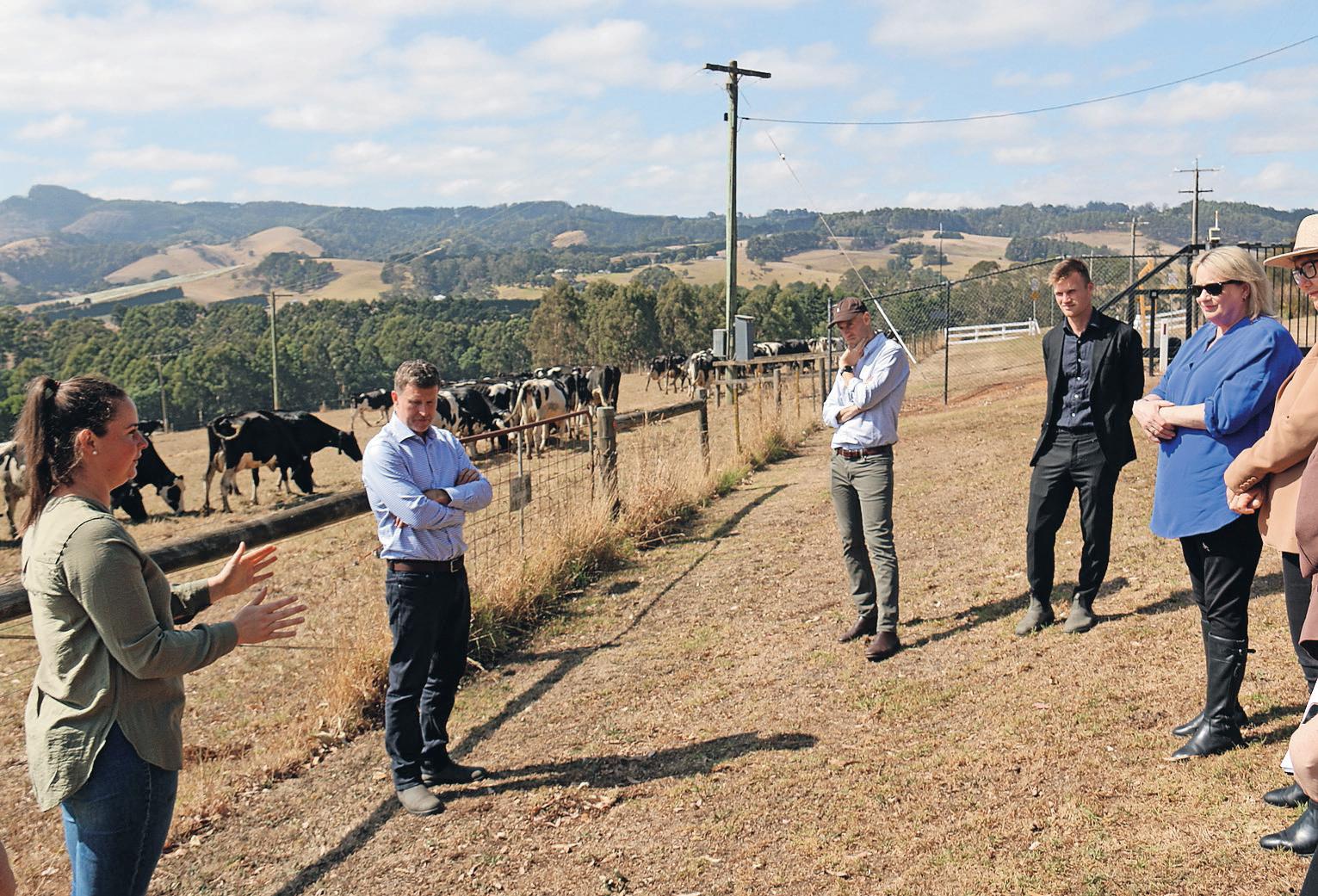
in monitoring their cows,” Ms Spence said.
“We’re working alongside other states and territories in the national Animal Welfare Task Group to examine the welfare implications of virtual fencing technology and the regulatory considerations that come with it.”
Dairy cattle at the SmartFarm are wearing solar-powered smart collars, giving farmers the opportunity to guide their animals within virtual fences through a mobile phone app.
Under Victoria’s animal welfare laws, electronic collars are currently only permitted for livestock when a scientific procedures licence is in place with Animal Ethics Committee approval.
Agriculture Victoria is engaging with industry, manufacturers (including Halter) and
researchers on virtual fencing to inform advice to government to consider changes that could allow wider use of the technology in Victoria.
Last December, Dairy NSW said recent legislative efforts and stakeholder support suggest that NSW may soon consider legalising virtual fencing, providing dairy farmers with a new tool for productivity, animal welfare and environmental stewardship.
A recent inquiry in NSW Parliament recommended permitting virtual fencing and herding for livestock, with consideration of the substantial evidence provided on its safety and benefits.
Internationally, virtual fencing is also on the rise.
The World Wildlife Fund’s Sustainable
Ranching Initiative is funding virtual fencing pilot projects in the United States.
“Virtual fencing is still a new and developing technology — but it could transform how ranchers raise livestock while rejuvenating native grasslands and protecting wildlife that rely on intact and healthy prairie,” the WWF says.
“Early adopters of the tool will provide valuable insight into its benefits, drawbacks, practicality and scalability.”
In Australia, Halter says it complies with all relevant laws and codes of practice in the jurisdictions in which it operates.
“Halter is committed to advancing regulations supporting high quality virtual fencing products in Australia to protect animal welfare

standards and enhance farm productivity,” the company says on its website.
“Halter is engaging with Australian state governments, regulators and industry representatives to share insights around how the Halter system works, research findings about how Halter protects animal welfare, and to share evidence of the many industry benefits of Halter’s system.”
Halter says that while it’s encouraging the NSW report recommends permitting virtual fencing, there were several recommendations in the report that present significant challenges that will inhibit adoption of virtual fencing in NSW and could inadvertently lead to worse outcomes for animals.
It has put forward a second opinion in response to the report.
Senior researcher for the Tasmania Institute of Agriculture at the University of Tasmania, Dr Megan Verdon, leads the Animal Production and Welfare research group and has been studying virtual fencing since 2017.
Addressing a recent Food and Fibre Great South Coast’s inaugural Southwest Showcase of Dairy Innovation, Dr Verdon said her research into the Halter system looks to quantify the potential benefits for the environment, animals and people.
This research is funded by the Tasmanian Government.
Separate research funded by Halter looks at the welfare of animals in their management system.
“They understood the importance of independent validation of their product and the need to demonstrate social licence and that any new technology meets or surpasses current animal welfare standards,” Dr Verdon said.
The research involved 160 mid-lactation cows split into four groups, two managed with normal electric fencing and two with virtual fencing.
“Firstly, we found that the technology works,” Dr Verdon said.
“The cows stayed behind the virtual fence 99.85 per cent of the time. When they did cross over, they only walked a metre then turned around, which is consistent with getting a stimulus and then reacting.
In the first week, all cows received stimulus pulses, which Dr Verdon said was needed for the animals to learn the association between audio and shock, but they were quick to learn and respond to then sound cue.
After four weeks, half of the cows received

zero shocks for the whole week.
For the cows getting shocks — on the first day of training they got between eight and 10 shocks, after that they got less than one shock per day.
“For every 100 interactions with the virtual fence, they got one shock,” Dr Verdon said.
She showed a video of virtual herding, with cows responding to an additional vibration stimulus to keep them moving forward.
“People are blown away when they see it happen in real life and how calm it is.”
For herding, after four weeks of the study, 40 per cent got zero shocks for the entire week.
“The cows that do get shocks experience about 1.5 a day during training and then after that once every two days. Most shocks when they were navigating out of the paddock.”
Dr Verdon’s research took a range of measures to check animal welfare and productivity and found no evidence that cows lost weight or produced less milk. There was only a slight reduction in grazing time but no difference in pasture utilisation or rumination time.
Researchers used milk to assess the physiological level of stress in cows.
“When cows become stressed, they release a hormone called cortisol into their blood and some of that gets into the milk, Dr Verdon said.
“We analysed 2500 milk samples and there was no evidence of more stress between the electric fence group and virtual fencing group.
“Our research based on a relatively simple grazing system shows that it’s not having a negative impact on their welfare as long as the technology has the right safety mechanisms to protect the animal, the right training regimes and the right design.”
Dr Verdon said her role was not to promote the technology but to provide data about the benefits or challenges to inform decisions of farmers and legislators.
Current research is seeking to quantify the benefits of virtual fencing.
“Some benefits are really clear, such as more precise pasture allocation and nutrition for animals, better land management, protecting waterways and increasing pasture utilisation,”
Dr Verdon said.
“The technology also has behaviour monitoring abilities with alerts of any abnormal behaviour which could be an early indicator of illness or injury.”
Research with farmers has found it can make a profound difference in their lives by freeing up time for more high-value tasks.
“I believe it can offer significant advantages
in terms of our environmental management, animal monitoring and in people’s lives,” Dr Verdon said.
“But to ensure we achieve all those benefits from the technology, we have to make sure it meets societal perceptions and that it’s used in a way that works with the animal.”
The research is investigating benefits to the environment, including improved soil health, waterway protection, reduced greenhouse gases and redistribution of nutrients.
It is also seeking to quantify if the technology improves work-life balance, upskills staff and allows more time for high-value tasks and reduces lameness in animals, improves reproduction, reduces culling and leads to better calving management.
“There are so many of the benefits we can’t put a dollar value on ... like getting a bit more sleep, going on holidays with your family,” Dr Verdon added.
However, some continue to have doubts.
The RSPCA says although there are claims that virtual fencing is an animal-friendly technology, there is a lack of research regarding the long-term impacts of this technology on animal welfare.
“One of the main welfare concerns of virtual fencing is the use of an electric shock, which, in order for the technology to be effective, must be sufficiently aversive that animals actively try to avoid it,” the RSPCA states.
“Another welfare concern of this technology is that it initially exposes animals to an environment of low predictability and controllability, which can lead to anxiety and psychological stress during the learning period
“As the virtual fence is not visible, it may be more difficult for some animals to learn compared with an electric fence, as there are no visual cues to guide them.”
Victoria’s dairy farmers are adamant that virtual fencing is right for the industry.
“We want it yesterday,” Victorian Farmers Federation United Dairyfarmers of Victoria president Bernie Free said.
“The government’s economic prospectus says they are open for business — this is what you call open for business.”
Mr Free said virtual fencing led to environmental and animal welfare benefits and improved workplace health and safety for employees.
“It should have happened when the
technology became available,” he said.
Mr Free attended the showcase conference and said after hearing Dr Verdon’s findings, allowing virtual fencing in Victoria was a “no-brainer”.
“It ticks so many boxes for all the things governments say they want to do, but for some reason they’re not walking the talk. They’re clearly not listening to what agriculture needs and wants.”
He dismissed any animal welfare concerns. “Dr Verdon’s research is showing the cows are less stressed when they have the opportunity to use virtual fencing.”
Mr Free also visited Ellinbank to view the research taking place in Victoria.
“I was extremely impressed with the way the cows could be moved, just by signalling to them that the fence had changed, and the amount of movement without a rush or concern from the cows.
“We’ve been lobbying the government for it at every possible opportunity and will continue to do so.
“My only reservation is that it can’t come quick enough. The advancement to animal health through this technology is phenomenal.
“I can only see an upside to it for animal health and for workers who don’t have to go out at four o’clock in the morning to round-up cows.”
Mr Free said the system could be used remotely in bushfires or floods to get cows to safe areas.
“Every way you look at it, there are advantages for the community, the environment, the cows and the dairy farmer.”
On a recent study tour to New Zealand supported by the DemoDAIRY Foundation and LIC, south-west Victorian AI technician Sam Wilson got to see virtual fencing in action.
The tour group visited farmer Pete Morgan who outlined the benefits of using virtual fencing.
Mr Wilson was impressed with what he saw.
“We turned up not long after milking time and the cows were sitting happily in the paddock,” he said.
“The cows’ collars just vibrate and they all stood up and started walking to the gateway. They could go out either one of two gateways. They started walking towards one and it beeped again and they slowly turned and started walking to the other gateway.
“The cows were all calm. They walked in their own time and weren’t under pressure. It seems like a much better way to round them up rather than on a motorbike.”

BY JEANETTE SEVERS
MORE THAN 300 people attended the Gippsland Red Meat conference, on February 18, with dairy farmers among attendees.
Stratford dairy farmer Jess Knight was a speaker on a panel of women farmers in one of the afternoon presentations.
Jess gained a law degree before buying a dairy farm with her partner, Stephen.
They have worked together ever since, building their future in the dairy industry.
Jess was until recently on the board of GippsDairy as a farmer representative.
She publishes a blog and a podcast about her life as a dairy farmer.
Conference sponsor Meat and Livestock Australia was represented by analysts Simon

Quilty, and Robert Hermanns from Mercado discussed the red meat market domestically and globally. They talked about meat processors that


have increased chilled infrastructure capacity in Australia.
In 2024, this increased the weekly beef kill by 13,000 head.
The South Gippsland Robotic Open Day on April 4 brought together more than 150 participants, including farmers and service providers, to explore the future of dairy farming.
Hosted by the Vagg family, who have been farming for three generations, the event showcased the latest advancements in robotic milking systems and other innovative technologies.
Throughout the day, attendees engaged with experts and learned about the benefits of robotic milking systems.
The sessions covered topics such as energy efficiency, ergonomic pit design and the advantages of advanced German engineering.
Farmers shared their experiences and success stories, providing practical insights into the integration of technology in dairy farming.
Participants had the opportunity to see first-hand the equipment and systems that have transformed the Vagg family’s operations.
Supplied by GEA, and installed and serviced by local dealership Gippsland Dairy Professionals, the farm highlighted several cutting-edge technologies, including: auto select gates, monitoring systems to track cow health and reproductive status, autonomous livestock monitoring using AI, an intensive effluent management system, and eight new GEA DairyRobots.
GEA Farm Technologies has a strong presence in Gippsland, in south-east Victoria, with a diverse product range and


customisable AMS platforms catering to farms of all sizes, ensuring each farmer can find solutions that meet their needs.
GEA said it was proud to partner with service providers like Gippsland Dairy Professionals.
“These partners not only sell and install GEA Farm Technology equipment but also
Simon Quilty said a herd rebuild in the United States would lessen beef supply from the US into markets where Australia competes. Robert Hermanns said Australian cattle were a source of trim meat for US mince.
The increased chilled capacity will have flow-on effects to cow prices.
Laura Grubb, from Greenham’s, told attendees that dairy cows were strongly sought for trim meat for minced meat in the US.
Professor Richard Eckard updated attendees with knowledge about methane and farm production systems.
Veterinarian Dr Enoch Bergman talked about building a better cow by optimising the success of heifers.
ɋ For more pictures, go to: https://www. dairynewsaustralia.com.au/news/hundredshead-to-meaty-conference/

service and support their client base, fostering long-term relationships,” GEA said.
“The South Gippsland Robotic Open Day was a resounding success, offering a glimpse into the future of dairy farming
“The Vagg family’s hospitality and the innovative technologies on display left a lasting impression on all participants.
“As the dairy industry continues to evolve, events like this play a crucial role in fostering knowledge sharing and collaboration among farmers, service providers and industry experts.”

BY RICHARD MEREDITH
WHEN CAMERON and Tracey Bawden installed CowManager almost four years ago, they did it to improve their dairy business and to help them enjoy their lifestyle choices with their family as well.
The Bawdens are a sports mad family and they have adapted their dairy operation so it can accommodate their sporting commitments without compromising their business.
“Installing CowManager has allowed us to be on the go with the kids five nights a week, and on weekends, when we do a lot of travelling,” Cameron said.
Their two daughters, now 10 and 12, play basketball in Gippsland, Melbourne and in other country regions. It’s not unusual for them to play or train every night of the week and on weekends.
Ainsley, the older of the two, is now in the state development program and Cameron also coaches, having been a talented junior basketballer.
They have been on their current dairy farm at Labertouche in Victoria’s West Gippsland region for six years.
They are on a lease-purchase arrangement, milking 250 cows at peak. Both Cameron and Tracey are from dairying families from Tasmania and Victoria.
“We have one full-time and one part-time
employee,” Cameron said.
“The full-timer milks in the evenings and that allows us to go to basketball with the kids.
“We both enjoy being with the kids and watching them play.”
Choosing CowManager’s ear sensor system was a no-brainer for Cameron, who had been through the full round of visual heat detection systems; putting stickers on cows in a herringbone, which posed OHS risks for staff, and fixed time systems, which he said don’t really add up with a small herd.
“I liked the ease of the ear tags but one of the clinchers for choosing CowManager was that Paul (Quinlan from World Wide Sires) got the quote through to us in four hours.”
That meant they were able to apply immediately for a government digital technology grant which paid for around 50 per cent of the installation cost of the CowManager system.
“The grants go out the door pretty fast, so Paul’s quick response made it possible for us to get an application in and receive the grant.”
Paul and Cameron installed the ear tags and set up the antennas around the farm. The system integrates easily with their management system, Easy-Dairy. One of the benefits of the integration between CowManager and Easy-Dairy is that there





is only one set of data to be input and this is updated once a day.
“CowManager links in very easily for small herds with little automation,” Cameron said.
The Bawdens use CowManager mainly for heat detection and cow health alerts.
“I learned very early on to believe the health alerts,” Cameron said.
“When a cow went down, CowManager sent an alert, and I did not act quickly enough.
“But now, if we’re away, it’s all on the iPhone. If we get a health alert on a cow, we can advise the worker which cow to check. He knows the cows.
“If we suspect a health problem ourselves,
we can check the cow’s health and its rumination on CowManager to confirm.”
Heat detection has become more precise using CowManager and once again, the system can be used to meet their lifestyle choice, as well as improving in-calf rates and making savings on semen.
“One of the advantages with CowManager is that it gives us optimum timing for joining. This is critical when we’re using sexed semen.
“In other situations, I can decide whether to use conventional or sexed if I know I’m going to be at basketball. That way we can work the joining around our lifestyle and optimise our chance of a pregnancy.”
Since installing CowManager, Cameron says they have halved their semen use.
“In almost four years we’ve never had to call on back-up or support. It’s good to know it’s there but we haven’t had to use it.”
Although he has not ‘crunched the numbers’ on CowManager, Cameron knows they are getting cows in calf quicker. This is because he can go to the phone, check the cow and mate her at the optimum time, ensuring more successful pregnancies.
“If anything, I would say we are probably not using CowManager to its full potential, but we are definitely getting good value for the dairy and for ourselves.”
Provided by CowManager. For more information, go to: https://www.cowmanager. com/australia










Power Systems Australia are the Australian AKSA distributor for a large range of Diesel, Gas & Hybrid generators for stand-by and prime applications. No matter what style or size of generator you are looking for, Power Systems Australia are your Generator specialists.



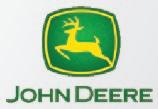






















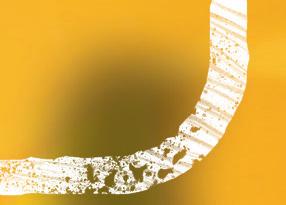
























































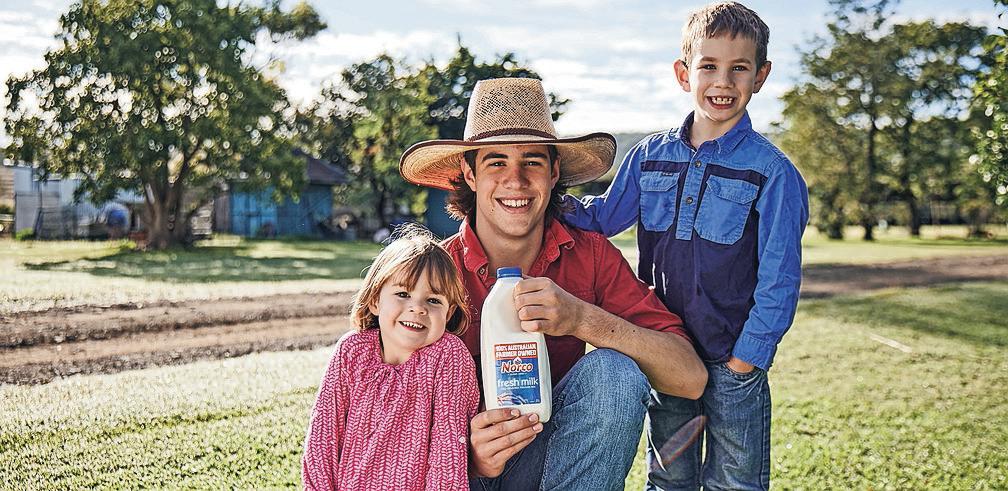

NORCO, AUSTRALIA’S oldest dairy co-operative, has received Canstar Blue’s Most Satisfied Customer Award for its fresh full cream milk.
Australia’s milk lovers voiced their opinion in the customer-rated Canstar Blue’s ratings for 2025, with Norco being the only Aussie milk to score five stars across customer satisfaction for taste, texture and consistency, packaging, and overall satisfaction.
Norco CEO Michael Hampson said Norco was proud to see Australian consumers rate Norco five stars for taste and overall satisfaction.
He said this recognition highlighted the dedication of the co-operative’s workers and the more than 280 dairy farming families in Norco’s supply chain.
“Being credited as the only five-star rated full cream milk for overall satisfaction shows our day-in day-out commitment to delivering high quality milk whilst also ensuring that all profits benefit our hard-working farmers,” Mr Hampson said.
“Buying Norco means more than just purchasing dairy products; it means directly supporting Australian farmers and it is rewarding to see consumers make that link in their responses to the Canstar Blue survey.
“We want to thank everyone who chooses to actively buy 100 per cent Australian farmer-owned products, especially now at a time when our hard-working farmers need to know just how much they’re truly valued.”
Eden Radford from Canstar Blue congratulated Norco for receiving the 2025 Most Satisfied Customer Award for fresh full cream milk.
“As a grocery staple, a bottle of milk can be found in almost every shopping basket at the supermarket, so it’s no small feat for Norco to earn the top-rated customer satisfaction award as decided by Aussie shoppers themselves,” Ms Radfor said.
“Norco received a top rating of five stars for overall satisfaction from its customers, as well as five stars for taste, texture and packaging. In fact, it was the only brand to receive the top rating for all three categories.”
The Most Satisfied Customer Award recognises brands that consistently deliver exceptional customer experiences, rated by real consumers. This accolade is based on surveying consumers and evaluating factors like overall satisfaction, value for money, customer service, and product performance.
IT WASN’T that many years ago when Brian Corr could only dream of owning his own dairy farm in Australia.
He grew up in Monaghan, Ireland, on a mixed dairy, beef, sheep and poultry farm, studied dairy at college, and went on to manage farms in Ireland, the UK and New Zealand.
On returning to Ireland and looking to take over the family farm, he decided to take a holiday to Australia, fell in love with the country, and it’s now the place he calls home.
For a while, he managed dairy farms in northern Victoria and farm ownership continued to feel out of reach for Brian and his schoolteacher partner, Myrid.
However, in 2022, they seized an opportunity to purchase a 155-hectare farm in Moyarra, South Gippsland, Victoria.
To move from management to farm ownership required debt to finance the land, equipment and vehicles.
While they always anticipated their first couple of years would be tight, they were keen to get off to the best possible start, so Brian called around to other suppliers in the area, asking for their help and advice.
That’s when a supplier told them about Saputo’s Dairy Investment Rebate (DIR).
The DIR is available to suppliers investing more than $50,000 in on-farm business opportunities, including purchasing a dairy farm, undertaking a major on-farm development, growing their dairy herd or working through succession of the family farm.
The investment support is offered on a yearby-year basis for a maximum of three years and is calculated on the amount of the investment; the amount of new milk solids; and total milk solids supplied by the farm.
For Brian and Myrid, the DIR helped get them across the line.
“We were very, very tight for cash flow and basically had no income for the first two months,” Brian said.
“All we owned was 100 cows and we knew that to be viable, we’d need to be milking 400.”
In addition to purchasing the farm, they needed to buy an extra 300 cows, a tractor and the equipment to run the farm.
They now peak at 500 cows, mostly crossbred Jersey Friesians, milking twice a day in a 30-unit swing-over dairy.
Brian said applying for the DIR was a straightforward process, with field services adviser Tim Cross coming out to the farm to help them with their application.
They’ve also since applied for Saputo’s Milk Cooling Rebate, allowing them to upgrade their vat from 6500 litres to 15,500 litres.
“Saputo’s Dairy Investment Rebate is available to suppliers investing more than $50,000 in on-farm business opportunities, including purchasing a dairy farm, undertaking a major on-farm development, growing their dairy herd or working through succession of the family farm.”
“The DIR is a great resource for any young farmer who doesn’t have a lot of cash flow coming in,” Brian said.
“That was definitely the trickiest part, but the DIR has allowed us to rapidly expand in an industry we love. You’ve just got to be willing to ask for help.”


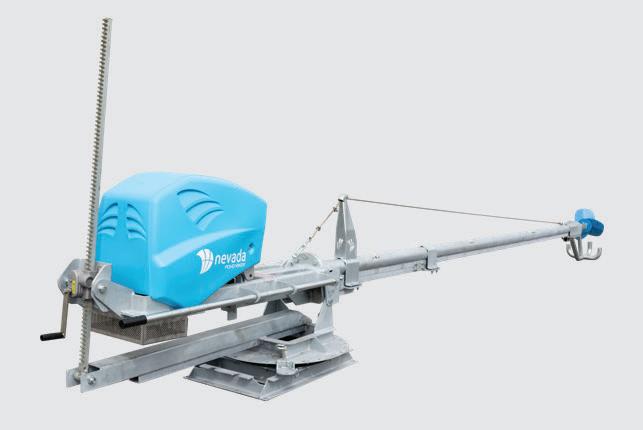


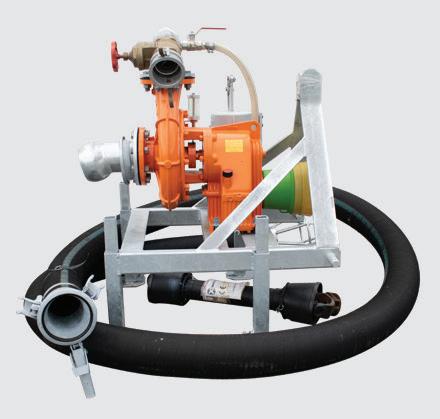
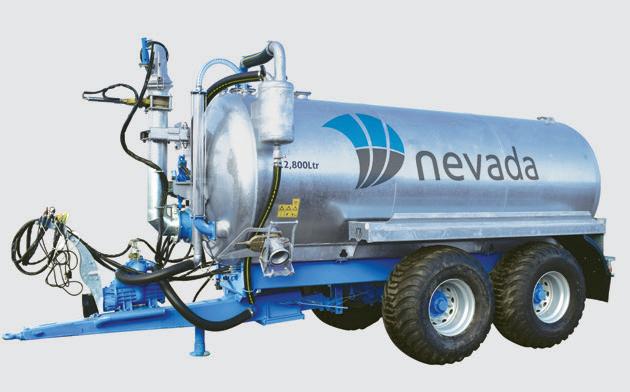



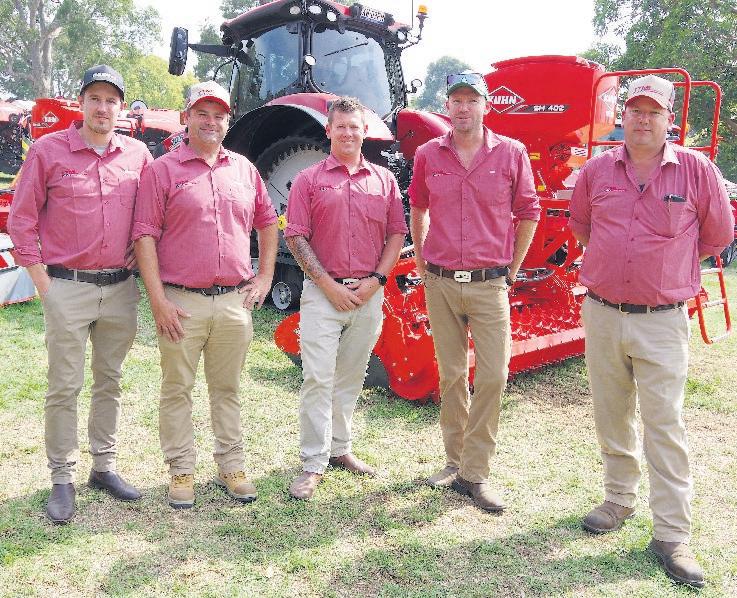
BY JEANETTE SEVERS
ATTENDANCE NUMBERS at Farm World in March were fairly consistent with previous years, despite a cost of living crisis, the impending federal election and global disruption around trade tariffs imposed by the United States.
Farm World is held annually at Lardner Park, with machinery and equipment exhibited across a 40-hectare site, just outside Warragul, in Gippsland, Victoria, among prime dairy country.
Farm World is traditionally held over three days and is one of the premier agricultural field days for exhibiting tractors, mulchers, milking machinery, disc and direct drill machines, rakes and silage wrap machines, alongside fencing equipment, feeder wagons and other essential

A total of 36,464 people paid to attend the event over the three days, with an additional
The 2026 Farm World will also be held over Thursday to Saturday.
“This change to two weekdays and a weekend day, rather than one weekday and a full weekend, was based on exhibitor feedback after the 2024 Farm World,” Lardner Park chief executive officer Craig Debnam said.
“This change will help reduce costs and support Lardner Park staff, Farm World volunteers, and exhibitors.
“It enables exhibitors to pack up their sites on Monday, and avoid paying unnecessary penalty rates for Sunday.
“The Farm World focus is on serving the needs of our primary audiences — farmers and their families — promoting agriculture, celebrating local producers, agricultural machinery and equipment suppliers and dealers and showcasing emerging farm technologies that enhance productivity and efficiency on farms.”

The annual Farm World’s awards were announced at the end of the first exhibition day
The Gendore site was named the Best Agribusiness Exhibit. Honourable mention in this category went to the TTMI site.
On A Roll Rural Fencing received the Best Technology and Innovation Exhibit.
As well as spending time among the machinery and equipment exhibits, farmers can attend the Telstra women in agriculture lunch and the CommBank breakfast forum.
This year’s breakfast discussion was led by Bernard Salt.
Farm World is dependent on an army of volunteers. As well as local farmers on the committee of management who volunteer their own and their families’ time, community groups benefit from contributing their volunteers’ time.
These groups include Warragul Lions Club, Warragul CWA, Warragul Rotary Club, Warragul Club of Drouin, Lardner and District Primary School, Drouin South Primary School and Ellinbank Football and Netball Club. See www.dairynewsaustralia.com.au for more from Farm World 2025.




MAKING THE right genetic choice continues to be a simple and objective decision for dairy farmers thanks to DataGene’s Good Bulls Guide, with the latest edition published on April 7.
As the tool of choice for dairy farmers wanting to improve their herds, since 2010 the Good Bulls Guide has showcased the best genetics for Australian dairy farmers, made breeding choices simpler and enabled them to choose bulls that tick the boxes for all the important on-farm profit drivers.
DataGene’s Peter Thurn said the Good Bulls Guide simplifies the marketplace by providing an objective comparison of bulls using the Balanced Performance Index (BPI), Health Weighted Index (HWI) and Sustainability Index (SI).
“Choosing a high BPI ‘good bull’ is the most popular way farmers choose their genetics and it’s not surprising because daughters of high BPI bulls perform better under Australian conditions,” Mr Thurn said.
“DataGene projects such as Improving Herds and Feeding the Genes have demonstrated the advantage and benefit to the farm’s bottom line by using Good Bulls [Guide]
“The Good Bulls Guide only displays the better bulls in each breed, but in saying that, there are still hundreds of high-quality bulls to choose from.
“To qualify, bulls must meet DataGene’s minimum criteria for Balanced Performance Index and be available for purchase.”
April’s Good Bulls Guide has 550 Holsteins, 134 Jerseys and 35 Reds, giving farmers plenty of choice for priority traits, preferred supplier and budget.
The Good Bulls logo is a trusted DataGene symbol of genetic objectivity and quality. It is displayed on qualifying bulls on DataVat. com.au , the Good Bulls App and many herd improvement businesses include it in catalogues.
Mr Thurn described the Good Bulls App as a great tool for those looking for genetic information on the run.
“Easily downloaded from the app store, the Good Bulls App allows farmers to filter bulls based on their needs and preferences,” he said.
“This filtering process enables farmers to create their own specialised short list to inform genetic purchasing decisions.
“The list can be sent to a semen reseller, giving farmers greater control and understanding of their breeding destiny.”
DataGene is an initiative of Dairy Australia and the herd improvement industry.
New for the April ABV release
DataGene is now publishing genetic conditions (genetic defects and characteristics) for cows and has expanded the number of genetic conditions and haplotypes reported through DataVat and the Good Bulls app.
There has been a correction to the Type ABVs for all breeds except Jersey. This
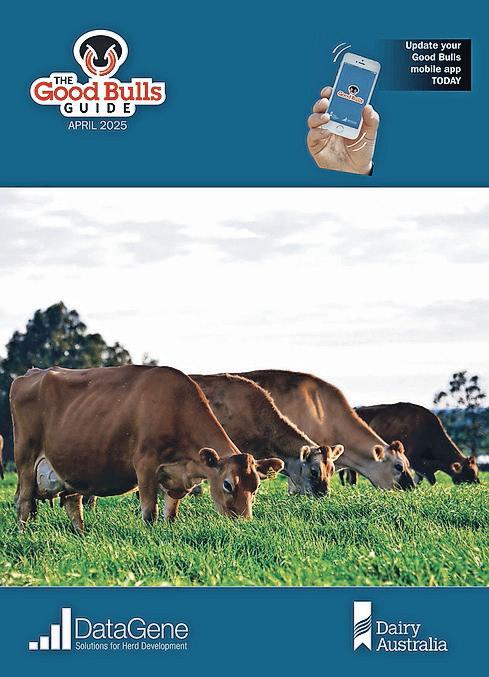
correction has resulted in changes in Type ABVs for some bulls.
The most noticeable impact is on a group of young bulls with low daughter numbers that have had daughters classified in the past few years. However, older bulls are also impacted due to the changes in contemporary groups. Some females are affected.
Jerseys are not affected because type evaluation for the breed uses a different model without type composites.
ɋ Download the Good Bulls Guide at: https://www.datagene.com.au/ good-bulls-guide/
ɋ To see the April ABV tables, go to: https://www.datavat.com.au/ abv-list-reports
ɋ For more information about the April ABVs, go to: https://www. datagene.com.au/wp-content/ uploads/2025/03/ABV-releaseUpdate-Apr-25.pdf
ɋ For more information on DataGene,
There has been a correction to Type ABVs for all breeds except Jersey. This has resulted in changes in Type ABVs for some bulls.
The most noticeable impact is on a group of young bulls with low daughter numbers that have daughters classified in the past few years. However, older bulls are also impacted due to the changes in contemporary groups. This correction is a one-off change, and future Type ABVs are a better reflection of genetic merit.

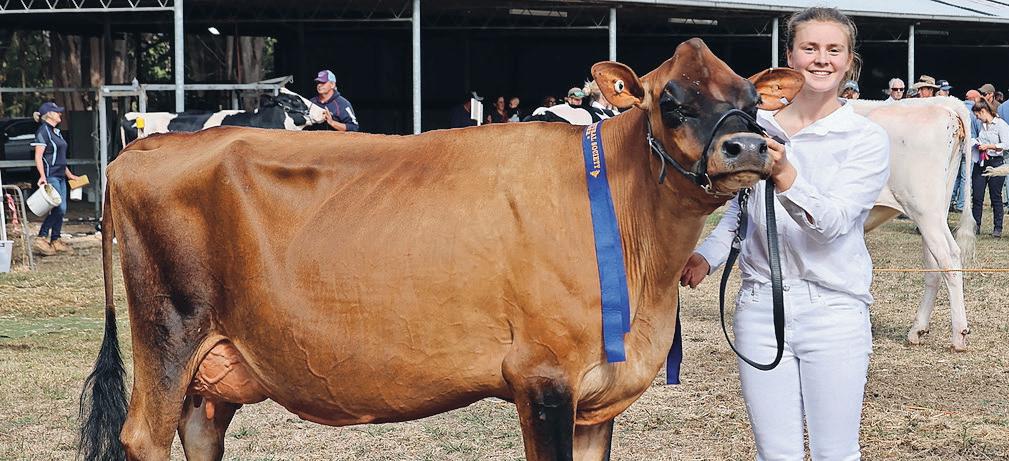
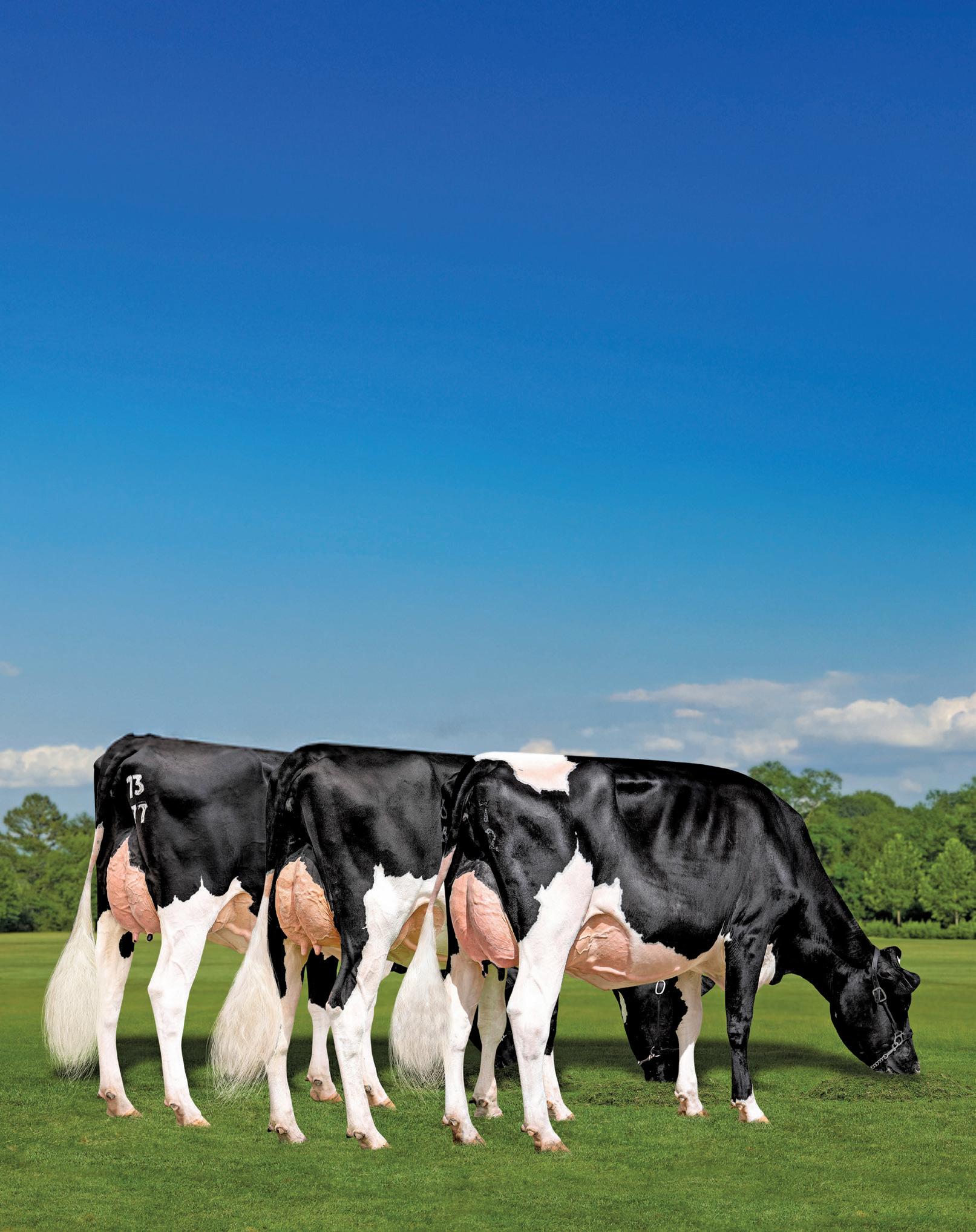
TERANG FARMERS Bryan and Jo Dickson have scored a rare double feat with both their Holstein and Jersey studs topping the latest Australian Breeding Values lists.
The April 2025 ABV release from DataGene shows Emu Banks Holsteins continued their run at the top with an average BPI of 376.
For the first time, Spring Banks Jerseys took top spot on the breed’s ranking with an average BPI of 279.
This is the first time since the formation of DataGene that one farmer has topped both major breed indexes.
It fulfils a long-held ambition for Bryan.
“It’s pretty cool; it’s something I have wanted to do for a long time,” he said.
Daryl Hoey had a similar achievement about 12 years ago, topping the Holstein, Jersey and Aussie Red ABVs under the former Australian Dairy Herd Improvement Scheme, the predecessor to DataGene.
“Daryl is the only person that I know of who has done it before,” Bryan said.
The Emu Banks herd consists of about 50 Jerseys and 30-40 Brown Swiss but the bulk is Holstein, with about 900 cows.
Jerseys were reintroduced to the herd about five years ago because of strong interest in the breed shown by Bryan and Jo’s daughter, Anna.
Emu Banks first topped the Holstein list in 2015 and returned to the top around 2020 and has maintained its edge since then.
Spring Banks has been a regular in second spot on the Jersey list but previous leader Con and Michelle Glennen’s White Star Jerseys, from Noorat, just 10 km from the Dicksons, has now slipped to second spot.
“I’ve got it once — how long I can keep it I’m not sure because Con has a great herd, but it’s an honour to top both rankings,” Bryan said.
When reintroducing Jerseys, the Dicksons concentrated on quality.
“We only bought and kept the best Jerseys we could find and culled the tail,” Bryan said.
They have the same philosophy with Holsteins.
“Weeding is just as important as breeding. We breed for type and production and we always feed them well to achieve good production, but we also weed out the lesser cows.”
In Holsteins, Bryan and Jo bred the second and third ranked BPI heifers.
Emu Banks Rizboy Tiffany 15111, with a BPI pf 573, was second and was recently sold for $17,000 to Agri-Gene and will contribute to their bull breeding program.
In third position is Emu Banks Rizboy Louanna 14977 with a BPI of 568.
Three of the top five genomic heifers are owned by the Dicksons.
Emu Banks was the highest herd for the Sustainability Index at 652 and number one for the Health Weighted Index (HWI) at 361. Bryan says he relies on facts and figures when breeding, and that genomics and sexed semen have helped to create a top ABV herd. The family has been farming west of Terang, in south-west Victoria, since 1989 and owns 485ha and leases a further 200ha.
HUGE GENETIC gains are just the icing on the cake for a South Australian dairy business that’s undergone an extensive transformation in recent years.
And the rewards are paying dividends on the business’ balance sheet as well as delivering a better work-life balance.
Ray and Marg Pearson, sons Shaun and Adrian, with Adrian’s wife Shannon, have increased their herd by 50 per cent to 900 cows and replaced an old dairy with a new rotary, and now their Holstein herd is within the top 200 in Australia according to its genetic merit. The family, from near Mount Gambier, have improved the Balanced Performance Index of their Burrungule Dairy herd by 161 per cent — moving from an average BPI of 67 to 175 in four years.
This represents a shift in the herd’s overall ranking to 137 in Australia from 576 in 2020. Underpinning this significant rise has been the family’s focus on breeding with top bulls on DataGene’s BPI and genomic testing.
“We started with genomics because we wanted to get better quality animals through the herd and see where our calves were at,” Shaun said.
“It also helped out with choosing our export heifers too; it made sure that when we were selling groups of heifers those groups never included any of our best ones,” Adrian added. Now, the genomic information for each heifer determines which ones are retained — generally those 250 BPI or above — and which
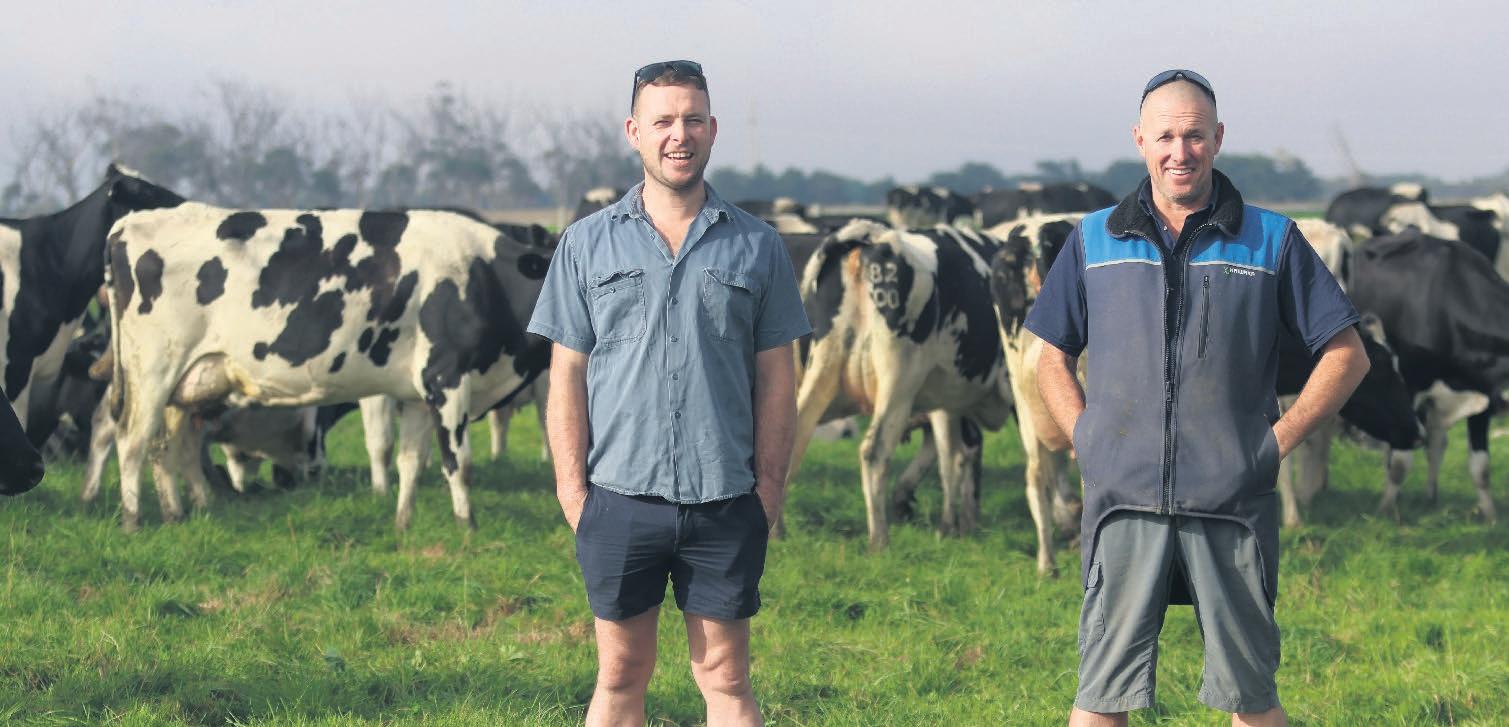
cows are bred to sexed semen.
Long-term breeding adviser, Genetics Australia’s Graham Heaver, helps the Pearsons choose bulls to fit their breeding goals.
He said a bull’s BPI is the most important consideration for selection and then they focus on improving any issues within the herd.
“If there are traits showing up, we tend to work on that,” Graham said.
“For example, if there are more lame cows, that would become a focus. But if a bull has a serious problem, he’s not going to be a high BPI bull; a high BPI bull generally has all the traits you want.”
It’s tough for the Pearsons to determine
the true production gain from their breeding approach, because there have been so many changes within their business in the past five years.
For example, they’ve seen a production increase of five to six litres/cow/day — to an average of 9500 litres/cow/lactation — in the new rotary dairy, where each cow is fed in the bail, according to its production. Previously, in their old herringbone dairy, the herd was blanket fed. But when it comes to their heifers, there’s no argument. Better genetics are making a mark.
Shaun said all heifers enter the dairy “at a consistent size” which makes them easier to manage and break into the dairy. They are also

more comparable to the cows in the herd — both in size and production.
Pulling up one heifer’s record on the dairy office computer, he points out the production capacity within the young group.
“Here’s one heifer, she’s 48 days in milk and doing 31.9 litres on 9.7kg (of wheat, canola and minerals),” he explained.
“As an average, the heifer group probably does around 29 litres, which is about 80 per cent of the average cow production.”
Choosing high BPI bulls has also improved calving ease within the Pearson herd.
The brothers are incredibly grateful for the time it gives them back for other things.
“I think one of the best things happening with calving ease, we are not pulling many calves at night,” Adrian said.
“Years ago, we’d be driving around the cows every night checking them.”
“And now once the last person drives out the gate, they [springers] stay in the paddock until the next morning,” Shaun added.
It’s a similar story with other health traits. For example, less mastitis saves time and money, delivering more milk in the vat consistently.
Moving forward, the family doesn’t want to lift herd numbers to more than 1000 cows and instead, will concentrate on improving their genetic merit to lift production, health and profitability.
They will continue to focus on breeding with high BPI sires but start to investigate traits such as feed efficiency and heat tolerance.



MORE OF ABS Australia’s next generation Holstein bulls are at the top of the industry than ever before, proving production and health traits are the key to on-farm profit.
Up to 28 per cent of ABS Australia’s top 50 Holstein bulls on the Australian Breeding Values Balanced Performance Index are more than 500 BPI.
The highest Daughter Fertility bull in the breed — sitting way out in front of the pack at 123 — is Boggy Creek TEDDY D RC, a western Victorian bull bred by the Delaney family, with the bonus of being a red-carrier sire.
At 573 BPI — and ranked second on the genomic ABVs — TEDDY D ticks all the health boxes without compromising traits such as calving ease and production.
ABS Australia business operations manager Bruce Ronalds said TEDDY D embodied everything commercial dairy farmers want to breed for.
“TEDDY D has extreme health traits, high production and ranks at the top of the industry for survival,” he said.
“It’s not surprising we’ve had a lot of early reseller interest in him; genetic decisions on dairy farms are driven by profit drivers and TEDDY D fulfils all these requirements.”
The highest Rock N Roll son in the industry for health, TEDDY D is 74 BPI above his sire and delivers production, survival, daughter fertility and mastitis resistance.
But TEDDY D isn’t just at the top of the BPI rankings. He — and another new ABS bull Waratah OBERON-P — are also more than 600
on the Health Weighted Index.
OBERON-P, at fourth on the genomic ABV BPI rankings, and 565 BPI, is another bull from a long line of big production and health-focused bulls and consistent cow families.
Bred by Gippsland farmers Stuart and Jacqui Tracy, their son Angus and daughter-in-law Ruby, OBERON-P’s high fertility reflects the genetic depth of their 600-cow herd.
A son of the popular homozygous polled TTM ELLIS PP, OBERON-P has elite Daughter Fertility at 117 and leading Mastitis Resistance at 113.
Rounding out the new ABS Australia genomic sires is Bellbrook KINGTIDE.
At more than 1000 on the Sustainability Index and 534 HWI, the Gippsland bull KINGTIDE has been bred for productivity and longevity, Mr Ronalds said.
“At 526 BPI he’s still at the pointy end of Australia’s Holstein genetics, while providing consistency across a range of traits that matter to Australian dairy farmers,” he said.
“KINGTIDE has what we call functional type — the strong dairy strength and good slope of rump that ensures he can work hard in any Australian commercial system with the hassles such as mastitis or fertility challenges.”
Polled perfection
ABS Australia’s dominance in the homozygous — or double P — market has again been confirmed by this latest ABV release.
With four of the top five PP Holstein bulls — including three at more than 500 BPI — dairy farmers not only have options for quality


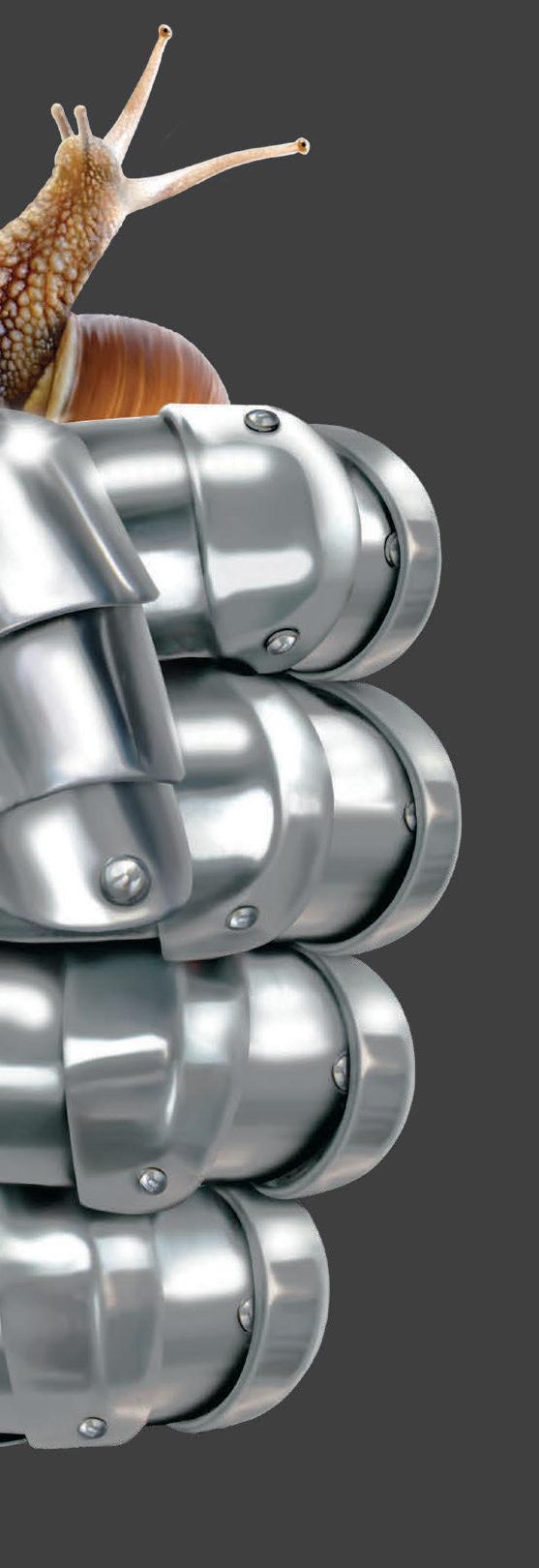

polled genetics, they don’t have to compromise anything to avoid the task of disbudding.
Vala Jeronimo CHAD PP is the highest ranked PP Holstein in Australia at 565 BPI.
“CHAD PP has been popular, with most farmers choosing him because he’s double-P, but they benefited from his 116 Daughter Fertility,” Mr Ronalds said.
“With 58 daughters milking in Australia, he’s still on the genomic list, but we are starting to see how his genetics are performing on-farm
and from all reports, he’s been impressive.” Farmer favourites TTM ELLIS PP 451 BPI and Bomaz POMPEII PP 452 BPI have continued to deliver for dairy farmers, while Denovo 4798 ESTATE PP has sired one of the most exciting new double-P bulls — Hayward-PP. Bred specifically for the Australia market, Denovo 21598 HAYWARD PP was the result of a strategic mating from an overseas high-ranking female that was part of a large number of overseas females ran through the Australian



on slugs & snails.
• Next generation, iron-based, all weather slug & snail bait with technology for maximum attractiveness, palatability and persistence
•Gentle on the environment, crops and non-target organisms
•Nil withholding period for grazing and harvest
•Certified input for organic production t

system a few years ago.
“We found a gem in Denovo Maserati 80330 who we mated to ESTATE PP who ended up with three calves, one of which is HAYWARD PP and an exciting new bull coming in August 2025 — a full brother of HAYWARD PP — who is also above 500 BPI,” MrRonalds said.
ABS JERONIMO P — in fifth place on the ABV proven list — now has just under 2000 milking daughters and hasn’t skipped a beat.
One of ABS Australia’s most popular sires in recent years, Mr Ronalds said JERONIMO P could double the number of milking daughters
in his proof in the coming year.
“Not only does JERONIMO P have the highest number of milking daughters in the top 10 proven Holsteins, but he has also continued to live-up to his genomics while adding daughters across the country,” he said.
“JERONIMO P is not only evidence of the effectiveness of genomics, he’s also a powerhouse bull that pays bills on farms and is easy to manage.”
HOOGERHORST DG OH RUBELS RED at 450 BPI remains inside the top 10 proven Holsteins and holds his spot as the number one
Type bull in the nation.
He is a bull that offers a lot to the commercial herds along with desired type for the stud sector.
Stellar young Jerseys
Northern Victorian-bred bull Kaarmona Jeronimo BRADY (CSCBRADY) — at 446 BPI and sitting at the top of the Jersey genomic BPI rankings — has cemented his place in the Australian dairy landscape.
“Other Jersey bulls have moved up and down and around him, but CSCBRADY has been stable,” Mr Ronalds said.
“He’s been on the market for 16 months and for the last year he’s been our biggest selling Jersey bull by far. There’s been big interest in him globally, and it’s not surprising.
“He’s equal number one for type at 113, number four on ASI and he’s over 500 for milk with positive components. Combine this with high survival, elite type and udders as well as mastitis resistance and you’ve got the complete package.”
For farmers seeking an outcross, Gippslandbred Ranleigh ROYAL FLUSH at 401 BPI provides positive milk and components with above average Daughter Fertility and is free of the defective JH1 Haplotype.
New western Victorian-bred Miami HEATHSTAR (CSCHEATHSTAR) has entered the market as one of the highest ranked bulls for Daughter Fertility at 108.
A Starlord out of a Navarian, CSCHEATHSTAR is also a home-grown outcross offering for the local sector.
Reds deliver
A clear leader at 295 BPI, SAUSVATN PP dominates the nation’s proven red sires when it comes to production and is also one of the highest HWI bulls on the Red market, with Daughter Fertility at 105 and Mastitis Resistance of 108.
NSW Aussie Red breeders Sam and Rachel Graham have recently calved SAUSVATN PP heifers into their herd of 330 at Numbaa and have been impressed with their health attributes and temperament.
“They were very easy to break into the dairy, very quiet cows, aggressive feeders and we are happy with their feet and legs — they are walking up to 1.5km to the paddock and keeping up with the herd,” Sam said.
“We’ve had no mastitis, they are really easy cows to work with.”
The highest-ranking genomic Red is NR HALLAND P at 339 BPI, delivering the health traits farmers want with Daughter Fertility at 102 and Mastitis Resistance of 104.
Mr Ronalds said the quality of the Norwegian Red offering was underpinning growing demand in Australia.
“From a Reds perspective, if it’s production you want, we have the two highest production bulls,” he said.
“ABS Australia has the number one Sustainability Index bull and the top three HWI bulls. There's a lot of choice for Australian Red breeders and those who use Reds as part of their cross-breeding strategies.”

28 SEPTEMBER - 6 OCTOBER,2025
Enjoy a trip to World Dairy Expo in Madison WI, including local herd tours, continuing on to an unforgettable visit to Select Sires in Ohio! Prize includes airfare to and from the USA as well as transport, accommodation and functions within the tour days.
•Contact your local rep or our office for details on how to enter
•All orders must be placed by 30th June 2025 with the raffle draw of qualified entrants on 1st July 2025


Cows
ɋ The Henry family’s Wilara herd of Tinamba, Victoria dominates the top of the Holstein ABV list. Five of the top six BPI cows come from this herd, which is ranked ninth nationally.
ɋ The top Balanced Performance Index cow is Wilara Nippon Jordonna Jordana with a BPI of 644. She is also the top cow for Sustainability Index and the mother of the Genetics Australia bull JORDLIV (BPI 562). Her sister Wilara Nippon Jordana (BPI 640) is second, while their mother Wilara Jeronimo Jorda is seventh (BPI 620).
ɋ Wilara Calister B Nickie is equal second with a BPI of 640. Sired by the polled bull TLGBOLTI, this young cow also carries the polled gene. Nickie is owned jointly by the Henry family and Craig Lister of Calivil, Victoria.
ɋ Jelbart Fedora 17383 is the top Health Weighted Index cow at 636 HWI. She is owned by the Jelbart family of Leongatha South, Victoria.
Genomic heifers
VikingGenetics provides you with top-quality Nordic genetics to boost your herd’s health, fertility, and productivity in every semen straw.




ɋ Craigielea Vicky 6682 is the number one Sustainability Index heifer with a SI of 850. Sired by the Agri-Gene bull ROULETTE, she is a daughter of the former number one BPI cow Craigielea Vicky 6151. She was bred by Bill Cochrane and family of Bamawm, Victoria, and is now owned by Pat and Brendan Nicholson of Girgarre, Victoria.
ɋ The top ABV Aussie Red cow is a VIKRTOKYO daughter 6487, owned by Paul Cocksedge of Tarwin, Victoria. 6487 has a BPI of 411. She is also the breed’s top Sustainability Index cow with an SI of 992.
ɋ In second spot is Blackwood Park 1416 at 398 BPI, owned by Phil Stasiw and the Clarke Family of Mt Gambier, SA.
ɋ 7696 is the top BPI Aussie Red heifer with a BPI of 338. She is owned by Davies Farm, Cooriemungle, Victoria. She is sired by the bull VIKRVESTY.
ɋ The top BPI and HWI heifer is Illawambra Rocknroll Deonie with a BPI of 576 and an HWI of 670. She is owned by Trevor and Leah Parrish, Barrengarry, NSW.
ɋ Bryan and Jo Dickson of Terang, Victoria, are the breeders of vthe second and third ranked BPI heifers. Emu Banks Rizboy Tiffany 15111 with a BPI of 573 is second and was recently sold by the Dicksons at the Settlement Sale for $17,000 to AgriGene and will contribute to their bull breeding program. Third is Emu Banks Rizboy Louanna 14977 with a BPI of 568. Three of the top five genomic heifers are owned by the Dicksons.
ɋ The Emu Banks herd of Bryan and Jo Dickson has retained top spot with an average BPI of 376. They are also the highest herd for the Sustainability Index at 652 and number one for the Health Weighted Index at 361. The Dicksons also have the number one Jersey herd (see below).
ɋ Moving up into second position is Rohan and Graeme Sprunt’s Kaarmona herd, Kaarimba, Victoria, with a BPI of 350.
ɋ George Wagner’s Rengaw herd holds down third position with a BPI of 344.


Gislev



VH Ascari
#4 Australian daughter Proven BPI Holstein





Australian daughter Proven Jersey for BPI, HWI & SI

ɋ Rockwella Farm Varley Judith continues to hold down top spot among the heifers for Sustainability Index with an SI of 973. She was bred by Wes and Rita Hurrell of Yankalilla, SA.
ɋ After a long reign at the top, Con and Michelle Glennen’s White Star Jersey herd from Noorat, Victoria, has been nudged into second spot by the Dickson family’s Spring Banks Jerseys with an average BPI of 279. This marks a fantastic achievement for the Dicksons, leading the way in in both Holstein and Jersey herds — a feat never before achieved.

Cows
ɋ The number one BPI cow is again Araluen Park Jiggy Sandra EX-90. Sandra was bred by Trevor Saunders and Anthea Day of Shady Creek, Victoria. She has a BPI of 568 and is also the Jersey breed’s top Sustainability Index cow at 1220 SI.
ɋ Aussie Reds: Ron and Sam Graham of Numbaa, NSW, again have the number one herd for all three key indices.
ɋ Illawarras: The Hamiltons Run herd of Graeme and Michelle Hamilton, Mt Gambier, SA, is the number one Illawarra herd for all three key indices.


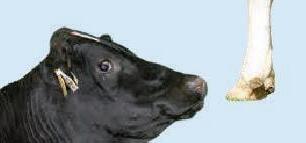


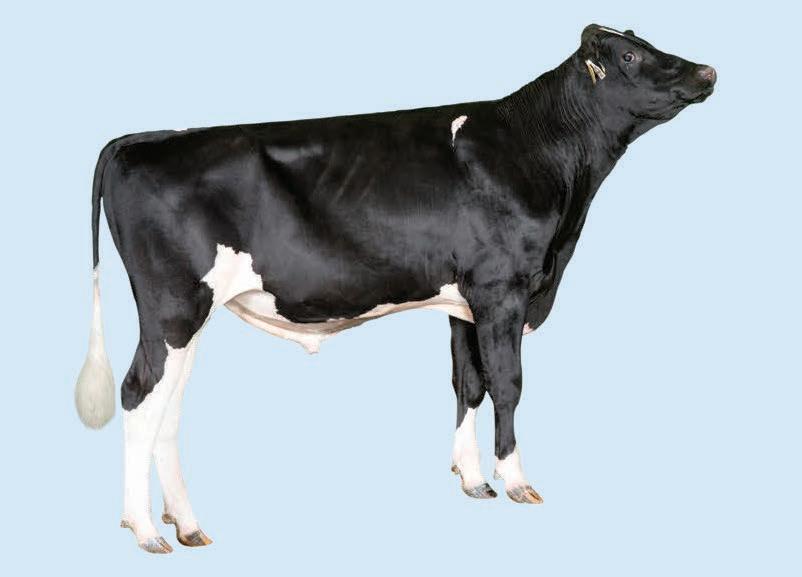

ɋ In second spot with a BPI of 527 is Beulah Gislev H Bouy 83 at two years. Owned by Daryl and Lani Hoey, Wonthaggi, Victoria, she is a daughter of the Viking bull VIKJGISLEV. Bouy also holds the top position for health traits with a HWI of 489.
ɋ Also from the Bouy cow family but from the Kaarmona herd of Rohan and Graeme Sprunt is Kaarmona Bosa Bouy 15, 85 at two years who is the number two Sustainability Index cow at 1061 SI. The Sprunt family farms at Kaarimba, Victoria.
Genomic heifers
ɋ The Hoeys are the breeders of the top BPI and HWI Jersey heifer. Beulah Star D Fairy 2 has a BPI of 432 and a HWI of 441. She is the 7JE01726 (Starlord) daughter of the former number one BPI heifer Beulah Dougg T2 Fairy.
ɋ Another Starlord daughter holds down second position: Araluen Park Starlord Sandra 3 is a daughter of the current number one BPI cow Araluen Park Jiggy Sandra EX-90, bred by Trevor Saunders and Anthea Day of Shady Creek, Victoria.
ɋ Ayrshires: Trevor Saunders and Anthea Day of Shady Creek, Victoria, have the top BPI and Sustainability Index Ayrshire herd.
ɋ Brown Swiss: P. and S. Balfour of Kanoona, NSW, have the top Brown Swiss herd for BPI, HWI and SI.
ɋ Guernsey: The Cleggett family of Glencoe, SA, are the leading Guernsey herd for BPI and SI.
Please note: Cows must be genomically tested.
– From DataGene.
ɋ For more information about the Balanced Performance Index (BPI), Health Weighted Index (HWI) and Sustainability Index (SI), get the ABV Pocket Guide at: https://www.datagene.com.au/wp-content/ uploads/2023/10/ABVs-Pocket-Guide-2022WEB-Version.pdf
ɋ Download the Good Bulls Guide at: https://www.datagene.com.au/good-bullsguide/
ɋ To see the April ABV tables, go to: https://www.datavat.com.au/abv-listreports
Australian-proven sires
ɋ 0200HO11983-Westcoast Rocknroll leads in the Holstein daughter-proven stakes. He has a BPI of 496 with a balanced production proof based on 217 daughters. (Semex)
ɋ Second is Carenda PILBARA, from the Kitchen family’s Carenda herd in WA. He is a high protein transmitter with 316 daughters in his production ABV. He is also the leading proven Sustainability Index bull with an SI of 1020. (Genetics Australia)
ɋ Third is the former number one genomic sire TOMMYDEE. Bred by John and Vicki Lillico of Smithton, Tasmania, TOMMYDEE transmits fantastic milk solids with great ratings for Survival and Fertility ABVs. (Genetics Australia)
Genomic bulls
ɋ The highest BPI genomic bull is the emerging sire 0200HO11791-Progenesis Radiostar at 621 BPI. Helped along by a small number of milking daughters, Radiostar excels for production traits and Survival ABV. (Semex)
ɋ The highest bull for Fertility ABV is the number two BPI bull, 29HO22290-Boggy Creek Teddy D. He has a BPI of 573 and a Fertility ABV of 123. He was bred by the Delaney family of Boggy Creek, Victoria and is their first bull to enter AI. (ABS)
ɋ Wilara JOBOLT-P is in third position, just one BPI point behind Teddy D at 572. This polled bull is from the high genetic merit Wilara herd of Trevor Henry and family, Tinamba, Victoria. (Genetics Australia)
ɋ Fourth position is held by 29HO22291Waratah Oberon-P with a BPI of 568. Bred by the Tracy family of Waratah Bay, this polled sire is also the first bull from this herd to enter AI. (ABS)
ɋ Three of the top 10 genomic Holsteins carry the polled gene.
Australian-proven sires
ɋ VIKJGISLEV, is the new leader on the Jersey daughter proven list with a BPI of 428. With 260 daughters in 30 herds, VIKJGISLEV is also the top daughter proven HWI and SI Jersey. (Viking)
ɋ Brookbora BORUNG moves down into second spot with a BPI of 385 based on 161 milking daughters. (Genetics Australia)
ɋ With more than 1000 milking daughters, DOUGGAN occupies third position with a BPI of 376. (Genetics Australia)
Genomic bulls
ɋ CSCBRADY bred by the Sprunt brothers of Kaarimba, Victoria is the breed’s leading BPI sire at 446. From their renowned Babe cow family, CSCBRADY transmits an amazing combination of production and type. (ABS)
ɋ TOWERHILL is the new number two genomic Jersey sire with a BPI of 419. Bred by Paul and Adam Lenehan of Crossley, Victoria, TOWERHILL is an extreme milk transmitter, which helped to propel him to the top of the Sustainability Index list with an SI of 932. (Genetics Australia)
ɋ 7JE01726-Primus Craze Starlord, is the top HWI sire. This solid fertility transmitter has a number of highly rated sons that will become available this year including SONGSTAR and ELSTAR, both bred by Mark and Philippa Flemming of Cobrico, Victoria. (WWS)
ɋ 252NR12344-NR Haaland-P leads both the Aussie Red BPI and Sustainability lists. This polled Norwegian Red sire has a BPI of 339 and SI of 797. (ABS)
ɋ Beaulands IVERSON is a new sire, coming in at number TWO with a BPI of 328. IVERSON was bred by the Graham family of Numbaa, NSW, the top ABV Aussie Red herd in Australia. (Genetics Australia)
ɋ The top Aussie Red HWI bull is 252NR12136HAUEN-PP at 283 HWI. This homozygous polled bull is a superior fertility and


protein transmitter. (ABS)
ɋ The top proven Aussie Red bull is SAUSVATN-PP with 39 milking daughters and a BPI of 295. (ABS)
OTHER BREEDS
ɋ Ayrshire: The leading Ayrshire sire is NZGSUPASONIC-Iwa Super Sonic with a BPI of 293. (LIC - Livestock Improvement Corporation)
ɋ Illawarras: The genomic sire Cluain Lyons, CNLYONS, is the leader at 302 BPI. This superior production transmitter was bred
by Graeme and Michelle Hamilton, Mt Gambier, SA which is also the current number one Illawarra herd. (Genetics Australia)
ɋ Guernsey: The top Guernsey bull is BLMAFIA, Brookleigh Rep Mafia at 203 BPI. In second spot is BLBENTLEY, Brookleigh Lock Bentley at 166 BPI. Both were bred by the Cleggett family of Glencoe, SA.
ɋ Brown Swiss: GGIVIP-VIP is the leading Brown Swiss bull at 250 BPI. 93SBJ03Hercules is in second with a BPI of 232. (GGI Australia) – From DataGene.





Mammary System





• 115 Daughter Fertility


• A2/A2 sire that is 75% black • Popular Fresh Sexed Semen Sire







BY DR ROBERT BONANNO
AT A time when dairy farming is becoming increasingly data-driven, wearable technology is emerging as one of the most useful tools for dairy farmers.
Wearable tech has evolved from fitbits and smartwatches on human wrists to make it onto the ears, legs and necks of dairy cows, offering game-changing benefits for herd health, productivity and farm efficiency.
This technology offers a powerful opportunity to really move a farm forwards.
One of the most significant opportunities offered by wearable technology in dairy farming is the ability to monitor individual cow health around the clock.
The various devices such as smart collars, leg bands and ear tags are equipped with sensors that track a variety of vital indicators including activity levels, rumination, temperature and resting or eating times.
The data collected from the device is fed into algorithms that help to create the various alerts that the tech is well known for.
This data allows farmers to detect early signs of illness, such as mastitis or gut upsets, often before any physical symptoms become visible. For example, a drop in rumination along with a reduced or irregular activity pattern may indicate that a cow is unwell and trigger a health alert.
Early intervention not only improves animal welfare but can also reduce treatment

costs and prevent production losses.
For many years, I have been advising farmers to use more non-steroidal anti-inflammatory drugs (NSAIDs) for mastitis cases.
Many people already do for the obviously sick cases, but many of the ‘health alerts’ are for mastitis cows with only quite mild visible clinical signs yet they are suffering from reduced rumination and activity indicating that they are actually systemically affected and would likely really benefit from a dose of NSAIDs.
Wearable technology can also play a crucial role in enhancing reproductive performance.
Accurate heat detection is consistently a challenge for dairy farmers, but wearable tech can now identify the changes associated with heat more reliably than heat detection alone and some advanced systems even track hormone levels or use machine learning (AI) algorithms to predict the optimal breeding time.
With real-time alerts sent directly to a smartphone or farm computer, and when integrated into other farm management software and hardware (such as sort gates) farmers can better time inseminations, increasing the chances of pregnancy.
In addition to health and reproduction, wearable tech can offer insight into feeding behaviour.
Sensors can monitor how much time cows spend eating, drinking and lying down — key



indicators of comfort and productivity.
When paired with automated feeding systems, this information can help optimise nutrition.
By understanding individual cow behaviour, farmers can also fine-tune their management.
For instance, if the data show less activity or rumination than usual across the whole herd it may indicate that there is a herd level dietary problem and early adjustments based on the data rather than waiting several days until the changes become obvious, can lead to a healthier, more productive herd.
In many cases, these wearable tech systems aggregate the data and present it in user-friendly way.
Some of the platforms can even automate alerts, generate reports or suggest some corrective actions based on analytics allowing
us to capture the ‘expert knowledge’ that has been embedded in the systems.
Especially in larger herds, this can be a game changer. Instead of walking the herd and trying to spot problems visually, farmers can rely on the technology to flag individual cows that might need a little extra TLC, saving time and enabling proactive care.
‘Health alert’ cows should be thoroughly examined and treated according to an appropriate protocol and not just randomly treated with antibiotics.
While there’s often a significant upfront cost associated with adopting wearable technology, most farmers who I work with who have adopted the technology are generally satisfied with the purchase.
I am often asked what is the ‘best’ option and my consistent answer is that it is the one that best integrates with your current farm systems and equipment like dairy shed and sort gate infrastructure.
And in herds who are considering a major investment in new dairy equipment I always suggest that they consider how wearable tech might integrate with the new infrastructure to ensure seamless compatibility.
ProDairy promotes proactive care and I believe that wearable technology in its various forms helps to achieve healthier cows and better welfare outcomes and I consider the technology a valuable management tool.
Dr Rob Bonanno is a ProDairy regional lead veterinarian.

BY GEOFF ADAMS
NORTHERN VICTORIAN farmers are facing a winter with limited facilities for the handling of dead stock.
ProDairy can assist you with the development of a tailored plan:
• On-farm visit by a ProDairy veterinarian.
• Review of the current biosecurity principles, the major risks and actions taken to reduce those risks.
• Development of a customised biosecurity plan.
Visit prodairy.com.au for more information.

In March the region’s largest knackery at Stanhope announced it would no longer collect dead stock from farms.
The Victorian Farmers Federation United Dairyfarmers of Victoria has been meeting with affected producers, rendering companies, and local government councils to try to find a solution to the problem which is causing stress and cost to producers.
VFF UDV president Bernie Free said they were committed to working constructively with industry and government to explore practical, long term solutions.
“This is about building a solution that works for producers and upholds the integrity of our livestock industries. The work has begun, and we’re in it for
the long haul,” he said.
Mr Free said they had talked with the Stanhope knackery owners and they were not discounting the possibility they could one day return to dead stock collection.
However, he said the company had some issues to work through and they had to be satisfied the service was economically viable.
Mr Free said the UDV had talked to Agriculture Victoria and the Environment Protection Authority to stress the need to find a solution to avoid any biosecurity risks.
“When you look around the farm, it’s not easy to find somewhere to bury them, that complies with the regulations.
“And undertaking the work can be difficult as the demand usually rises at the busiest times of the year.”
Auld’s Stock Removalists ceased collecting dead stock from farms on Monday, March 17. The business will continue to take live animals to be euthanased from the Goulburn Valley.
DAIRY FARMERS are under increasing pressure to safeguard their livestock, equipment and operations from a range of security threats.
From cattle theft and the threat of activist trespassing, to biosecurity breaches and cyber risks, protecting productivity is becoming just as important as managing herd health and milk output.
While traditional security measures play a role, advances in on-farm surveillance technology are now helping dairy operators take a more proactive approach to security and farm management.
John Hill, co-founder of Land Watch Australia, says interest in surveillance solutions among dairy farmers is growing rapidly as farms look for ways to enhance security, improve efficiency, reduce risks and deliver peace of mind to producers.
John shares his top tips on smart surveillance for dairy operations:
Shed security: Monitoring movement within and around the sheds can help deter theft and unauthorised usage of farm machinery.
Video records of work areas can provide crucial insights in case of an accident, ensuring that safety protocols are being followed and providing evidence for incident reviews.
Animal and employee welfare: Surveillance can clarify events in case of an injury or dispute, assisting in investigations and safety improvements.
Quality control: Reviewing footage of milk transfers can help maintain hygiene standards and track any anomalies in the collection process.
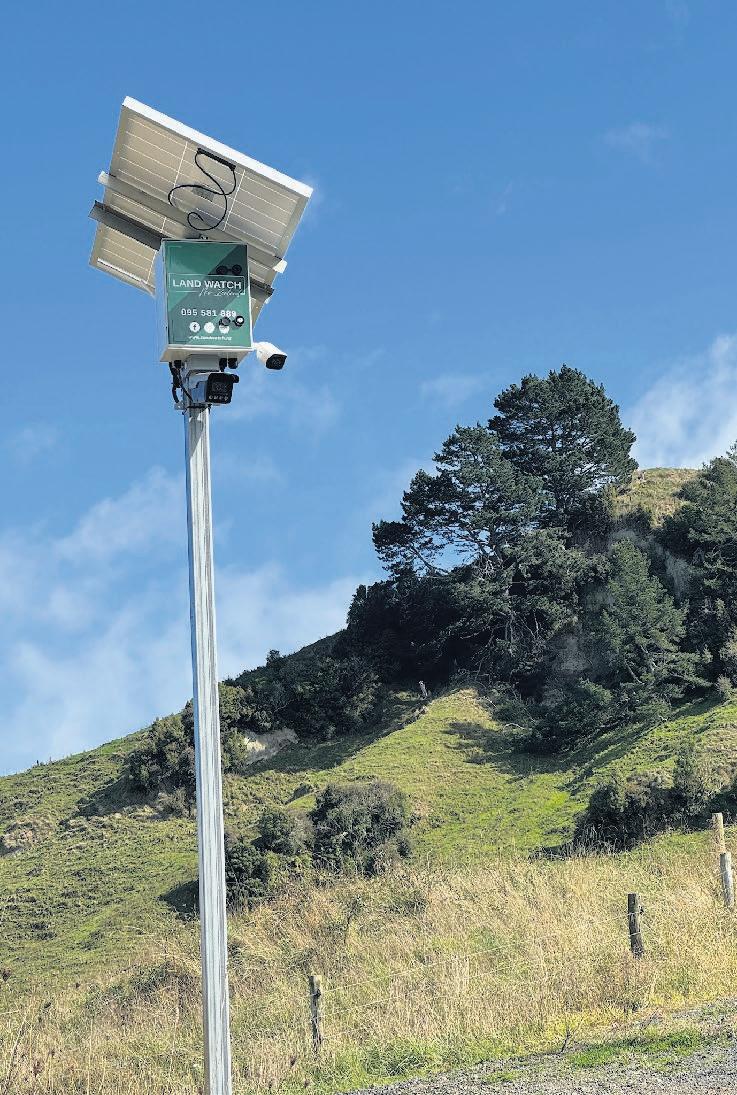
Fuel surveillance: Fuel is one of the most expensive inputs on a farm, and its proper management can save thousands of dollars annually.
Paddock surveillance: Livestock is the heart of all operations. Keeping an eye on stock movements, herd conditions, and calving paddocks can improve feed and stock management and animal welfare.
For more information, go to: https://landwatchaustralia.com.au/
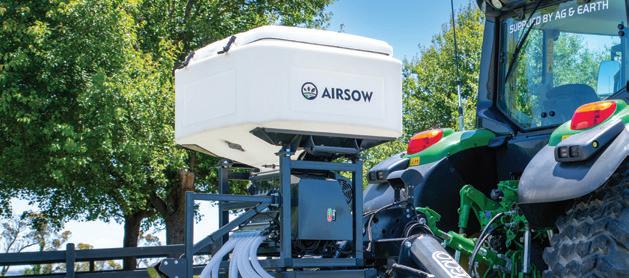




IF YOU ARE A LARGE HERD OWNER AND DO MULTIPAL TRIPS FEEDING YOUR
Theseaward
Theseaward
These
With it’s bale capacity, clever design and rugged construction, that makes the Multi bale feeder simple and easy to operate.
